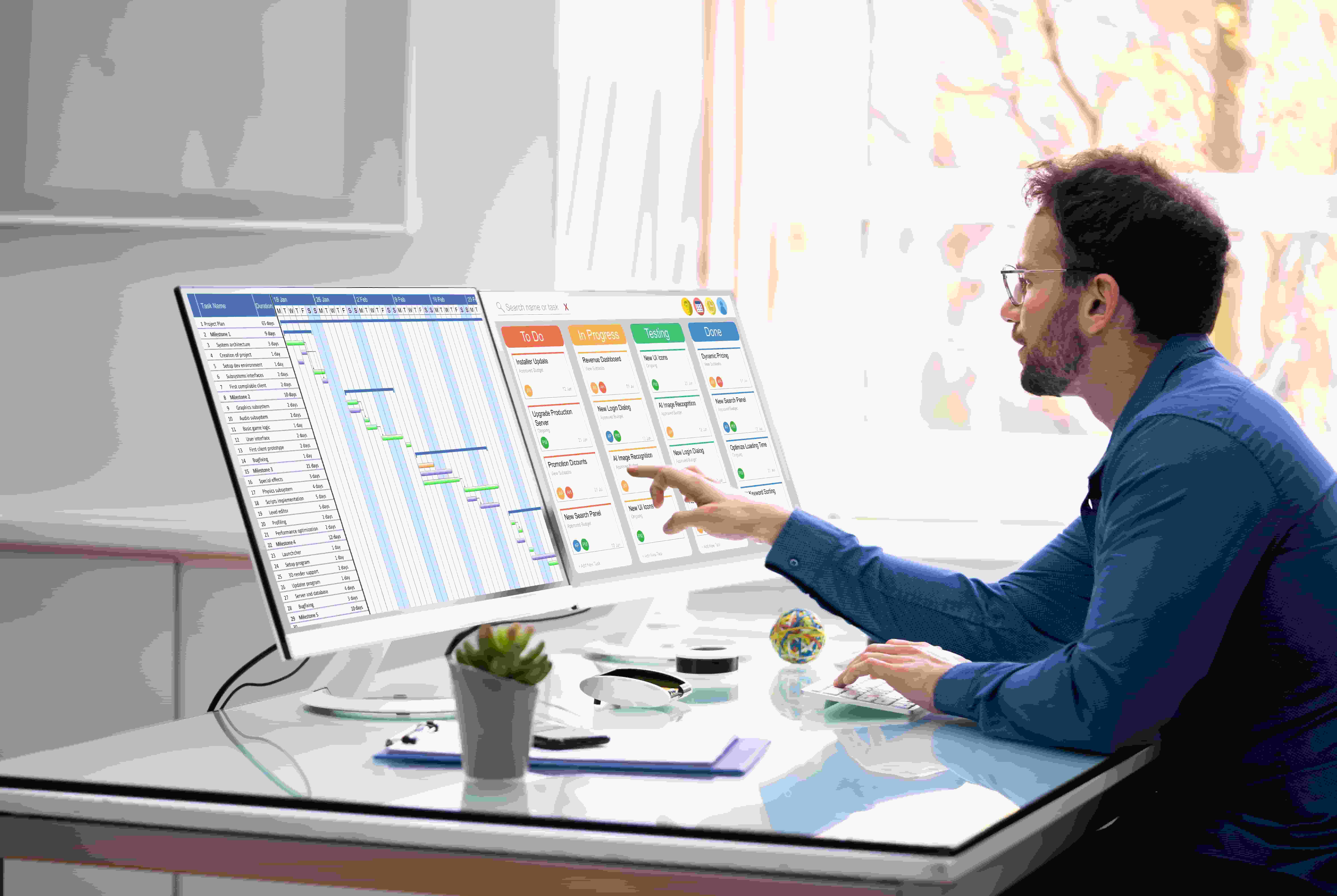
Giving your team access to a free Kanban board is crucial in today’s working environments, where efficient communication and streamlined workflows are a priority.
This awesome tool has single handedly transformed how teams visualize and manage workflows, firmly establishing itself as one of the preferred project management tools among many leading organizations thanks to the simplicity and efficiency it adds to workflows.
Using the right free Kanban software for your team offers a cost-effective way to organize tasks and improve productivity, making it one of the most efficient online collaboration tools. However, with so many options now available, zoning in to the best option can be tricky. In this blog post we will roundup the best free Kanban tools available, their standout features, and how to make sure you pick the right one for your needs.
Table of Contents
Our List of Highest-Performing Free Kanban Board Options
- Teamplate: All-in-one productivity for detail-driven professionals who need to track everything in one place.
- ClickUp: Simplify and scale project workflows for teams that crave efficiency and collaboration.
- Trello: Visual project management made simple for creative teams and task-oriented individuals.
- Kanban Flow: Lean and fast task tracking for multitaskers who value time management and simplicity.
- Miro: Collaborative whiteboarding for teams who innovate through visuals and brainstorming.
- Jira: Powerful issue tracking and agile solutions for software development and tech-focused teams.
- Kanboard: Minimalist Kanban for self-starters and teams seeking a lightweight, open-source solution.
- Pipefy: Streamlined process automation for operations professionals seeking better workflows.
- Kanban Tool: Smart task boards for teams that value insight-driven planning and productivity.
How We Evaluate & Test Free Kanban Software Apps
Why should you trust our advice about the best free Kanban board? Our experts have tested the top options currently present on the market first-hand, so as to be able to make genuine, personal recommendations.
- Each of our reviews is the personal opinion of our team of experts:
- We only include free Kanban software that offers all features we deem essential
- We shortlist according to the most popular brands on user-review sites
- We do not accept payments for any of the reviews
- We follow a transparent review process that is applied to each free Kanban board
- We base our reviews on fact, rather than the subjective opinion of one person
Moreover, each of our reviewers signed up for all the free Kanban board software reviewed, and created projects for each one of them to see how they compare across a span of time. We did this over a three-week period, where we tested functionalities like workspaces, deadlines, communication tools, task dependencies, and more.
What Makes the Best Free Kanban Tool?
We’ve tested each free Kanban software for a range of features that we consider essential for any team, whether looking for excellent startup tools or software that’s appropriate for larger, longer-established teams. These features include:
- Ease of use: The best free Kanban board is the one that’s extremely intuitive and allows your team to hit the ground running, without extensive training necessary.
- Affordability: While these are all free Kanban boards, not all of them include the entire suite of features for free. The more features available for free, the higher our scores.
- Comprehensive functionalities: Ideally, the best free Kanban software will allow you to carry out all your daily project management and communication needs from one, single dashboard. Apps that require multiple integrations of third-party apps will score lower.
- Customization options: Each team has different workflow and management styles, so you need to be able to adapt your chosen free Kanban board as best suits your style. Our highest-scoring apps are those that offer you the flexibility to do so.
Following our comprehensive testing process based on the above four criteria, here is a summary of the highlights we discovered.
The Best Free Kanban Software Compared
| Tool | Best For | Standout Feature | Pricing |
| Teamplate | Teams seeking an all-in-one collaboration platform. | Fully integrated communication tools, including chat, video calls, and screen recording, within a Kanban-style interface. | Free with all functionalities included. |
| ClickUp | Teams requiring a highly customizable and comprehensive project management solution. | Multiple views (list, board, Gantt, calendar) and extensive customization options. | Free plan is limited to 100MB storage; paid plans start at $7 per user/month. |
| Trello | Individuals and small teams preferring a simple, visual task management tool. | Intuitive card and board system with Power-Ups for added functionality. | Free plan is limited to 10 boards per workspace and basic automation; paid plans start at $5 per user/month. |
| KanbanFlow | Individuals and small teams focusing on personal productivity and time management. | Built-in Pomodoro timer and time-tracking capabilities. | Free version includes very basic task management and time tracking; premium version at $5 per user/month. |
| Miro | Teams emphasizing visual collaboration and brainstorming. | Infinite canvas for whiteboarding with real-time collaboration. | Free plan limited to three editable boards, pre-made templates, and core integrations; paid plans start at $8 per user/month. |
| Jira | Software development teams practicing agile methodologies. | Advanced issue and bug tracking with Scrum and Kanban boards. | Free plan limited to 10 users & includes Scrum and Kanban boards, backlog, and agile reporting; paid plans start at $7.50 per user/month. |
| Kanboard | Users seeking a free, open-source, and self-hosted Kanban solution. | Lightweight and minimalistic design with basic Kanban features. | Free and open-source. |
| Pipefy | Operations teams aiming to automate and streamline business processes. | Customizable process templates with automation capabilities. | Free plan limited to basic process management and email templates; paid plans start at $18 per user/month. |
| Kanban Tool | Teams needing visual project management with time-tracking features. | Real-time collaboration with time-tracking and performance analytics. | Free plan limited to two boards and two users with basic features; paid plans start at $5 per user/month. |
Top Free Kanban Software Options
Now that you can see what each of the best free Kanban board options offers, it’s time to delve into more detail by taking a look at the pros and cons for each tool, and the key features to look out for. We have also given consideration to what other users say by checking out reviews on the popular user-review site Capterra. All the below user comments and images for each free Kanban board are lifted directly from the site.
Teamplate
CEO Melanie H has this to say about Teamplate: “I appreciate the efficiency of the collaboration tool, particularly in facilitating seamless communication for globally dispersed teams. Additionally, I find the practicality of having file transfer within the same software to be a standout feature, enhancing overall workflow efficiency. It’s very easy to use, powerful and efficient”.
Other users on Capterra all praise this free Kanban board software for offering all its features entirely for free. While they note that there is limited lack of integrations with third-party tools, they also appreciate the fact that these are not needed as all functionalities like email, chat, video conferencing, and more, are all included directly within the dashboard.
| Feature | Details |
| Overview | A fully free , all-in-one Kanban board with collaboration and time-tracking features. |
| Key Features | Real-time collaboration, integrated chat, email, calendar and project templates, document sharing and storage. |
| Pros | Offers all features at no cost from one single dashboard, removing the need for multiple integrations. |
| Cons | Limited external integrations. |
ClickUp
Capterra user Orla P had this to say: “Allowed me to project manage and keep track of where things were and what is being worked on and completed”. However, she also added that she “didn’t like this tool as it was quite clunky and inefficient way for me to keep track of them”.
Other users describe this free Kanban board as being more versatile than Asana, but considerably more expensive than truly free options like Teamplate.
| Feature | Details |
| Overview | A comprehensive project management suite offering an intuitive Kanban board view. |
| Key Features | Custom statuses, drag-and-drop functionality, time tracking, and integrations. |
| Pros | Highly customisable; suitable for teams of all sizes. |
| Cons | Some advanced features can overwhelm new users. |
Trello
Capterra user Marco B had this to say through Linkedin: “Trello has great views and is easy to set up and use, especially if you are working on an event or workshop and want the people to cooperate before, during and after the event. The fact that it is very popular means that in these cases your participants will be more likely to have an open Trello account than any other similar software so it really speeds things up.”
However, the ‘free’ aspect of this free Kanban software tool didn’t rate as highly with him, as he stated: “You will go through the limit of boards in the free account very fast.”
| Feature | Details |
| Overview | A visually appealing tool focused on task organization using boards, lists, and cards. |
| Key Features | Drag-and-drop interface, customizable labels, Power-Ups for added features. |
| Pros | Intuitive design; quick setup. |
| Cons | Most of the essential features require paid add-ons. |
KanbanFlow
General manager David O. describes this free Kanban board as “great for starters”, adding that it is “free and easy to use. We decided to use KanbanFlow instead of tracking projects in Excel and it was a great decision”. On the cons side, he adds: “The program is not feature rich so there are likely more robust tools on the market. However, for people starting with tools like this, simplicity can be a good thing.” Other users like Sam P were disappointed that “the swimlanes are a paid feature, which are a nice to have,,, you also can’t move completed tasks any past date you wish”, indicating that the free features may not be comprehensive enough for serious teams.
| Feature | Details |
| Overview | A lightweight Kanban tool tailored for personal productivity and small teams. |
| Key Features | Built-in time tracking, task management, analytics. |
| Pros | Extremely simple to use. |
| Cons | Minimal integration options. |
Miro
User Barbara C praises this free Kanban board for having “greatly simplified our ability to efficiently prepare for and address issues with current initiatives. It has reduced the need for back-and-forth emails by providing a more engaging medium for sharing information”.
However, other users like Ben E disagree, stating that they “consider Miro to be more of a hindrance than a help to my work, mostly because of the obstructive, slow, and clicky user interface. And Sascha M notes that “it is tough to stay up to date with all the recent feature additions and capabilities”.
| Feature | Details |
| Overview | A versatile tool offering Kanban boards alongside visual collaboration features. |
| Key Features | Templates, infinite canvas, real-time collaboration. |
| Pros | Great for team brainstorming. |
| Cons | May feel complex for beginners. |
Jira
While many users appreciate the host of Jira functionalities, most of them also find the interface too difficult to use. Colleen M, for instance, states: “Jira is often evolving and changing its user interface which causes confusion in larger teams and it’s often difficult to establish best practices”. And Oni J agrees, claiming that ““sometimes the interface can feel a bit clunky and overwhelming especially when you have to manage complex projects“.
User Abu R appears to reflect what most of the reviews are saying, summarizing it as: “The initial learning curve can be steep, making it overwhelming for new users. Configuring advanced workflows might also be complex.”
| Feature | Details |
| Overview | Designed for agile teams, Jira provides excellent Kanban and Scrum support. |
| Key Features | Advanced workflows, integrations, developer tools. |
| Pros | Ideal for large teams and technical projects. |
| Cons | Challenging setup for new users. |
Kanboard
This free Kanban board is highly popular with teams that are familiar with open-source software. CEO Eric M states on Capterra: “It has all the features I need but not the bloat. I like that because it’s self hosted, my data is my own. Because it’s open source and free, I don’t worry about the cost of additional seats when I add new users.”
However, most users also acknowledge that it offers very basic functionalities that can sometimes be a bit too clunky. An anonymous, but verified, reviewer also stated: “It is sometimes difficult to get an overview when there are many tasks. Difficult to see priorities and progress. Reporting is perhaps not that good.”
| Feature | Details |
| Overview | An open-source Kanban tool designed for simplicity and ease of use. |
| Key Features | Drag-and-drop tasks, customizable workflows. |
| Pros | Lightweight and straightforward. |
| Cons | Requires self-hosting; fewer features compared to competitors. |
Pipefy
This free Kanban board is well-loved because it’s very intuitive and takes no time to get used to. User Laura H writes how “those who use a wide variety of software for their jobs will appreciate how intuitive and easy to learn Pipefy is to use (like me). My processes are readily and effectively automated. It’s easy to use and has been invaluable in helping me run my business.”
On the flipside, consider that it may not serve all your teams’ needs. In Krishna L’s words, “the technology does not appear to be powerful enough to manage intricate tasks. While the layout is nice, it lacks information about their community. Despite reading and experimenting with the product, complex questions remain.”
| Feature | Details |
| Overview | A process management tool offering a structured Kanban experience. |
| Key Features | Custom workflows, automation, templates. |
| Pros | Excellent for process automation. |
| Cons | Limited integrations in the free plan. |
Kanban Tool
While the free features available for this free Kanban board are quite basic, they are also efficient. User Merline B describes how: “I had the basic features available for free. The application was seamlessly accessible via browser and the mobile app. Must-have features worked with no issue at all.”
However, a verified reviewer disagreed, writing through LinkedIn: “I’m not particularly impressed with this one despite its affordability”, with the due date functionality being particularly criticized.
| Feature | Details |
| Overview | A visual collaboration tool with Kanban boards and time tracking. |
| Key Features | Real-time updates, analytics, customizable workflows. |
| Pros | Easy to use; offers insightful analytics. |
| Cons | Advanced features locked behind paywalls. |
How to Choose the Right Kanban Software
If you prefer to carry out your own testing using different free Kanban board apps, we’re still here to help. Here’s how to choose the right Kanban software for you by following our tried-and-tested process.
| Priority | Elements to Consider |
| Lock down your specific needs | Identify what you need most from a free Kanban board: task tracking, collaboration, integrations, or reporting. Define your must-haves and nice-to-haves. |
| Check which features are actually free | Review the platform’s free plan. Ensure essential features like unlimited boards or users are available without hidden costs. |
| Consider scalability | Evaluate if the free Kanban board can grow with your team. Look for upgrade options and potential limitations that could impact long-term use. |
What is Kanban board software?
Are you here looking for a free Kanban board because you heard it’s the best thing in remote collaboration tools since instant chat, but you’re not quite sure what makes it so great? Worry not – here’s a simplified explanation of what to expect from this type of software.
All free Kanban board apps revolve around three cornerstone features: boards, lists, and cards. You can switch, add, and change between these using a drag-and-drop feature to make things easy.
- Kanban boards: think of these as a virtual workspace that give you a bird’s eye view of your entire project.
- Kanban lists: these are the workflows contained within your Kanban board, and can be as basic as To Do, In Process, and Completed – or as complicated as you require, with additions like For Review, Scheduled, Rejected, and so forth.
- Kanban cards: these are the individual tasks within your Kanban lists that you drag from one list to another along the pipeline until they’re completed.
Why Teamplate is our Highest-Rated Kanban software
We’re not gonna lie, all the free Kanban boards we reviewed above will make an excellent choice. They all offer excellent features that will help you and your team streamline your work process, whether you’re fully remote or not, and whether you’re a small start-up or a larger organization. If they didn’t, we wouldn’t have included them in our list of best free Kanban software.
That said, we believe that Teamplate goes the extra mile for two, hugely-important reasons:
- It is genuinely, 100% free. The vast majority of other Kanban board options reviewed above will at some point require you to pay something. The only two that don’t are Teamplate and Kanboard. However, the latter is limited in functionalities and doesn’t offer a comprehensive, all-in-one solution. It is an excellent option for solo freelancers, but can’t match Teamplate if you’re working as part of a team of whatever size.
- It is extremely intuitive and won’t require any learning curve. While free Kanban boards like Trello also possess this feature, they don’t have all the capabilities of Teamplate. Other apps that have all the capabilities, such as Jira, are more complicated to use.
The verdict is in: we 100% recommend Teamplate as our highest-rated free Kanban board. If you would like your team to start benefitting from this free, all-in-one solution now, get in touch here.
Finding free Kanban board software tools online is relatively easy nowadays. It feels like every app developer has launched their own version. The trick is finding one that works efficiently across all functionalities and does what it says on the box, offering you access to the majority of features without asking for a paid subscription.
We’ve asked a set of independent reviewers to take a deep dive into this topic, issue, taking a close look at the most popular options available and putting them through various tests. Here are our top recommendations, based on a series of rigorous testing sessions.
Table of Contents
10 Best Free Kanban Board Software to Try
Right below we’ve compared our experts’ curated list of 10 top free Kanban board software tools based on performance and on the free features available. Be aware that the latter may change from time to time, so it’s always best to go directly to the source before subscribing. However, based on the hands-on research we’ve conducted, you can get a very good overview of what to expect for free from each app.
| Tool | Free Plan Features |
| Teamplate | Unlimited Kanban boards, unlimited users; includes chat, video calls, boards, calendar, data room, and spaces. |
| Kitchen.co | Kanban project management tools available, specific free plan details not listed |
| Trello | Unlimited personal boards, up to 10 team boards, unlimited users, 10 MB file attachments, very basic automation, 1 Power-Up per board |
| Asana | Unlimited Kanban boards, up to 15 users, unlimited storage, access to basic features, advanced features like timelines and automation require a paid plan |
| Wrike | Unlimited Kanban boards, up to 5 users, 2 GB storage, basic task management features, advanced features (Gantt charts, custom workflows) require a paid plan |
| ClickUp | Unlimited Kanban boards, unlimited users, 100 MB storage, access to most features with limits on advanced tools (e.g. Goals and Portfolios) |
| KanbanFlow | Unlimited Kanban boards, unlimited users, basic features; advanced tools (e.g., time tracking, integrations) require paid plan |
| Kanban Tool | 2 Kanban boards, up to 2 users, 1 MB file attachments, basic features; advanced tools (e.g., time tracking, analytics) require paid plan |
| Monday.com | Unlimited Kanban boards, up to 2 users, 500 MB storage, basic features; advanced views (timelines, calendar views) require paid plan |
| Jira | Unlimited Kanban boards, up to 10 users, 2 GB storage, access to basic features; advanced features (e.g., advanced roadmaps) require paid plan |
Which is the Best Free Kanban Board Software Tool?
Our experts’ analysis of the best free process management software that’s currently on the market, revealed that Teamplate offers the best free Kanban board software hands-down, given all the advanced features that it includes for free. We based our decision on a series of data-driven, testing sessions that took place across five mock projects. Further down, we will list our experts’ findings in more detail.
How we Reviewed the Top 10 Free Kanban Board Software
Our reviewers had three main priorities while conducting their testing:
- Identifying which free Kanban board software offers the most comprehensive task management and task tracking functionalities
- Sourcing that that offered the biggest number of these functionalities for free
- Discovering which tool also added extra features such as chat, screen recording, email and forth.
We found that many free Kanban board software tools were only free up to a certain extent. Some of the tools, like ClickUp and Monday.com, offer the entire suite of functionalities – but only to a very limited number of users. While they may be excellent options for freelancers, reality is that teams are usually composed of more than two or five people, which will make a paid subscription necessary.
Other tools, like Asana, Wrike, and Jira, allow a large number of users on their free Kanban board software plan, but most of the necessary advanced features will not be accessible unless you upgrade to a paid plan. This also kind of defeats the purpose, as any team needs comprehensive free online collaboration tools to function properly.
Why We Chose Teamplate as the Best Free Kanban Board Software
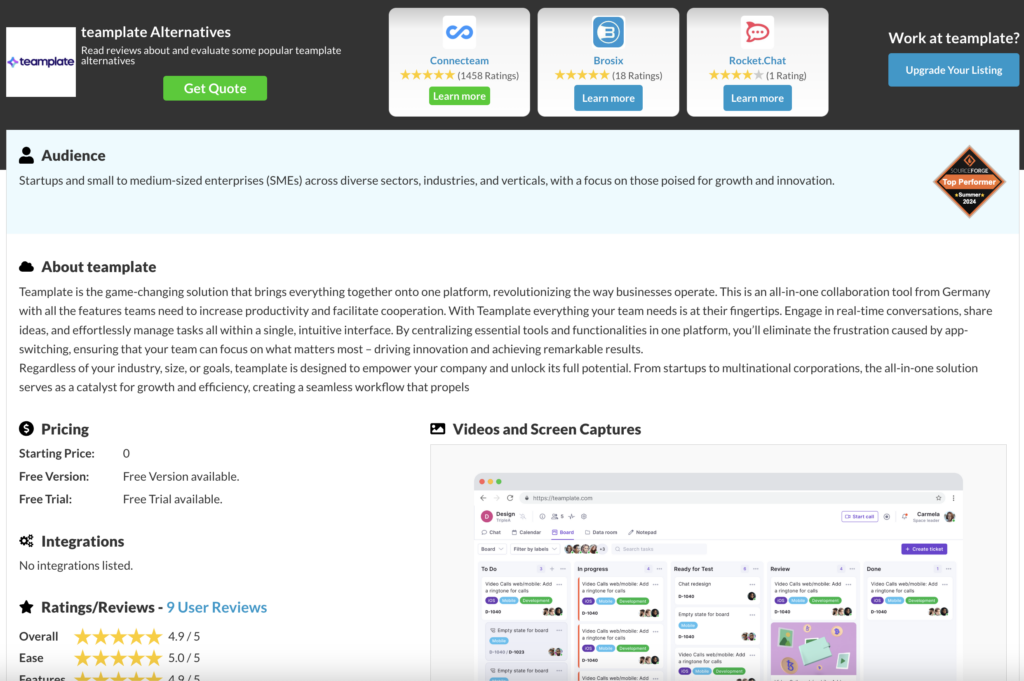
Teamplate, on the other hand, hits all the requisites our independent reviewers look for in free Kanban board software. You can onboard your entire team (including external partners) and you will have access to all functionalities on the free plan. Additionally, this free Kanban software offers a truly comprehensive dashboard that goes beyond the regular project management tools, with calendar, chat, and email integrations as well as designated Spaces for further collaboration and a highly secured data room.
In view of this, it would be difficult to find a free Kanban board software that performs better than Teamplate. However, we will be reproducing our findings about each individual tool in further detail below. To start using it at no cost, get in touch with our Teamplate team.
Teamplate – Best Overall for Full Collaboration & Task Management
Allows you to collaborate effortlessly with unlimited boards and advanced tools for every project included for free.
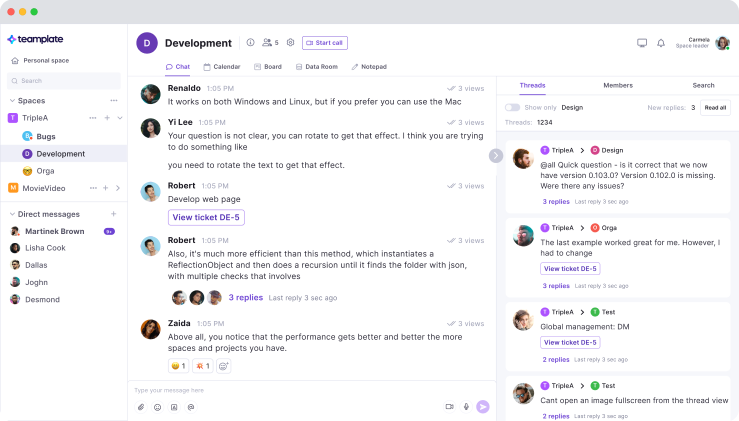
Which Features Can You Access in the Free Plan?
Teamplate’s free Kanban board software plan is literally unlimited. For €/£/$0 you get a comprehensive suite of features created to help any team achieve seamless team collaboration and project management.
- Unlimited Kanban Boards, where you can create and manage multiple boards to visualize and track project progress.
- Unlimited Users, with the possibility of inviting and collaborating with an unrestricted number of team members.
- Integrated Email, unlimited email access to all your team members right within the platform.
- Chat Functionality, allowing you to engage in real-time messaging with individuals or groups.
- Screen Recording, making brainstorming, note taking and presentations more effective.
- Video Calls, so you can conduct virtual meetings directly within the platform and record them, for 100% effective remote collaboration.
- Calendar Integration, where you can schedule and manage events, deadlines, and milestones to keep the team aligned.
- Data Room to securely store and share documents and files, ensuring easy access to members of the team who are granted secure access.
- Spaces, where you create dedicated areas for different projects or teams to maintain organized workflows.
- Checklist Functionality, helping you break down tasks into subtasks with checklists.
- Backlog and Sprint Management to facilitate agile project management.
- Aggregated Calendar and Ticket View that offer a unified perspective of all assigned tickets and events across various spaces.
Paid Plans
There are no paid plans available as Teamplate is 100% free. No paid subscriptions are needed to access advanced features.
Kitchen.co – A Lightweight Solution
Offering simple, but effective, Kanban management for today’s agile teams.
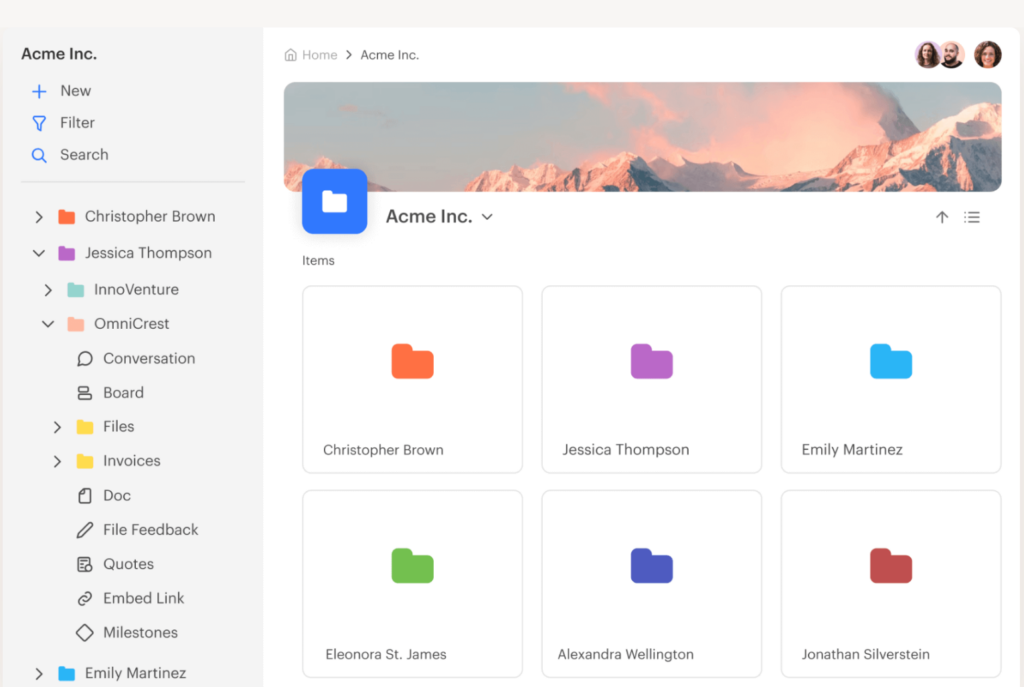
Which Features Can You Access in the Free Plan?
- 2 Internal Users, so it’s best suited for freelancers rather than organizations.
- Invoices & Quotes for financial reporting.
Paid Plans
Teams numbering more than two users won’t be able to use the free Kanban board software and will need to upgrade to a subscription. Kitche.co favours Lifetime Plans, so the outlay is quite expensive. The first choice is priced at $599 as a one-time payment and includes unlimited internal users, unlimited clients, and projects.
The Lifetime 5-User Plan is available for a $299 one-time payment and offers the same features as the Unlimited Plan but is limited to five internal users, so it only works for very small organizations that have no intention of ever scaling up.
Trello – For Multiple Workspaces
A highly visual organizer, bringing teams together with simplicity.
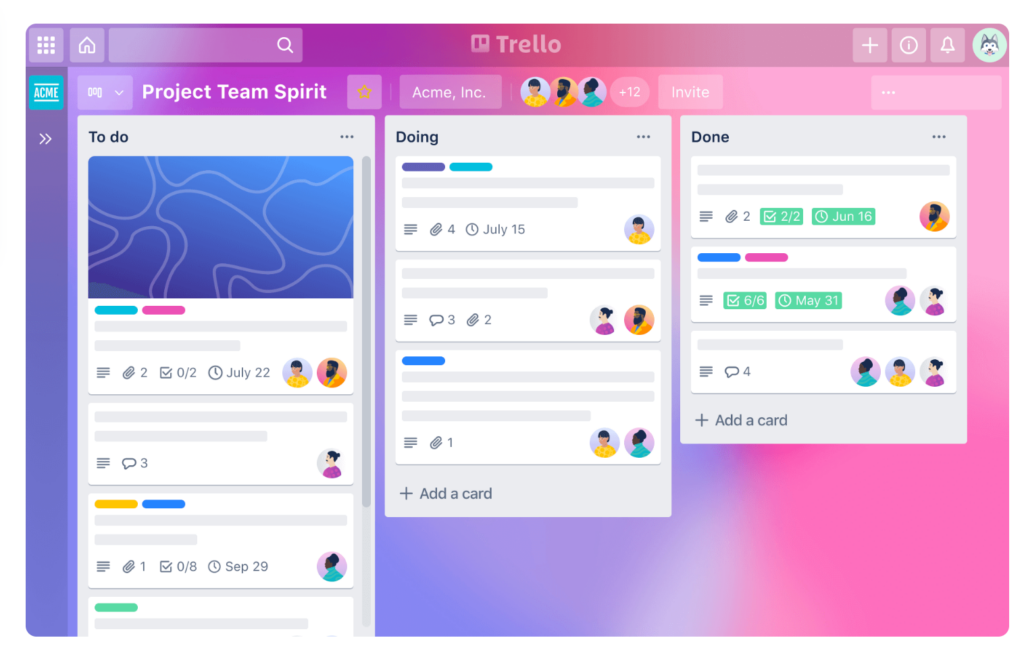
Which Features Can You Access in the Free Plan?
- Unlimited Personal Boards to create and manage as many personal boards as needed for various projects.
- Unlimited Cards and Lists, so you can add an unrestricted number of cards and lists to boards.
- Unlimited Members to invite and collaborate across departments.
Paid Plans
Teams requiring project management beyond the basic cards will need to sign up to Trello’s Standard plan, which costs $5 per user/month and includes advanced checklists, unlimited boards, custom fields, and unlimited storage with a 250MB file size limit.
While this is great for small teams scaling beyond the free plan, if you’d like to add features like timeline, calendar, table, dashboard, and map views you’ll need to upgrade to the Premium plan for $10 per user/month.
Asana – Excellent for Task Visualization
Allows you to organize, track, and hit your project goals with ease.
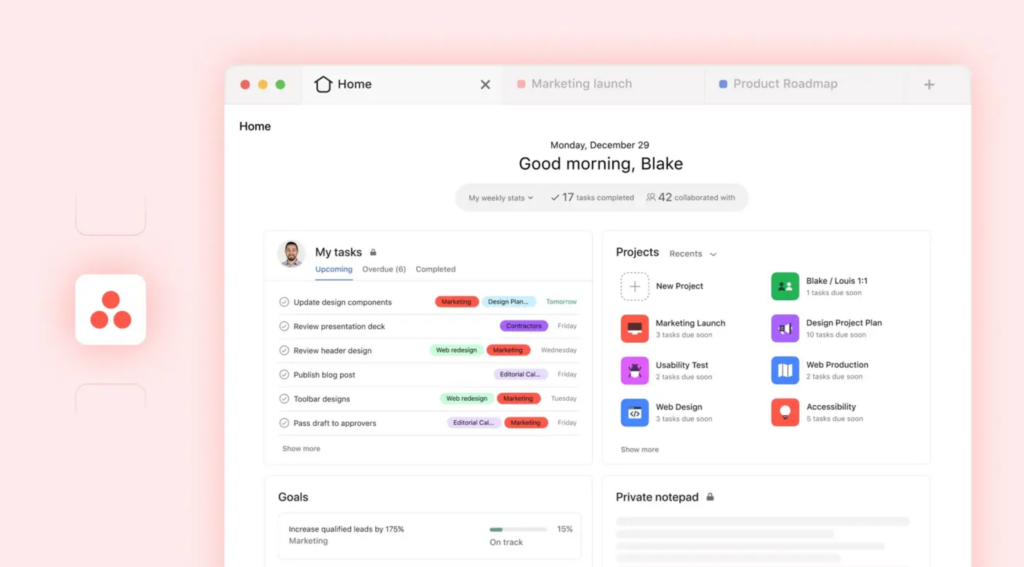
Which Features Can You Access in the Free Plan?
- Unlimited Tasks to create and manage an unrestricted number of tasks.
- Unlimited Projects that you can initiate and oversee without limitations.
- Unlimited Messages, allowing you to communicate seamlessly with team members.
- Unlimited Activity Logs, giving you access to comprehensive records of all activities and changes within your projects.
Paid Plans
Asana’s features really come into their own not when using the free Kanban board software version, but when you subscribe for one of the four paid plans—Starter, Advanced, Enterprise, and Enterprise+. The Starter plan costs $10.99 per user per month and should be enough to cover the needs of small to medium-sized organizations.
It includes unlimited tasks, projects, messages, and activity logs, along with unlimited storage (100MB per file). You will also have access to list, board, and calendar views, as well as integrations with over 100 free apps like Microsoft 365, Google Workspace, and Slack.
The Advanced plan, at $24.99 per user per month, is far from being a free Kanban board software. However, it introduces advanced functionalities such as timeline (Gantt) views, goals, portfolios (up to 100), workload management, and advanced reporting metrics.
Wrike – For Flexible Workflows
Helps you empower your team with streamlined task management.
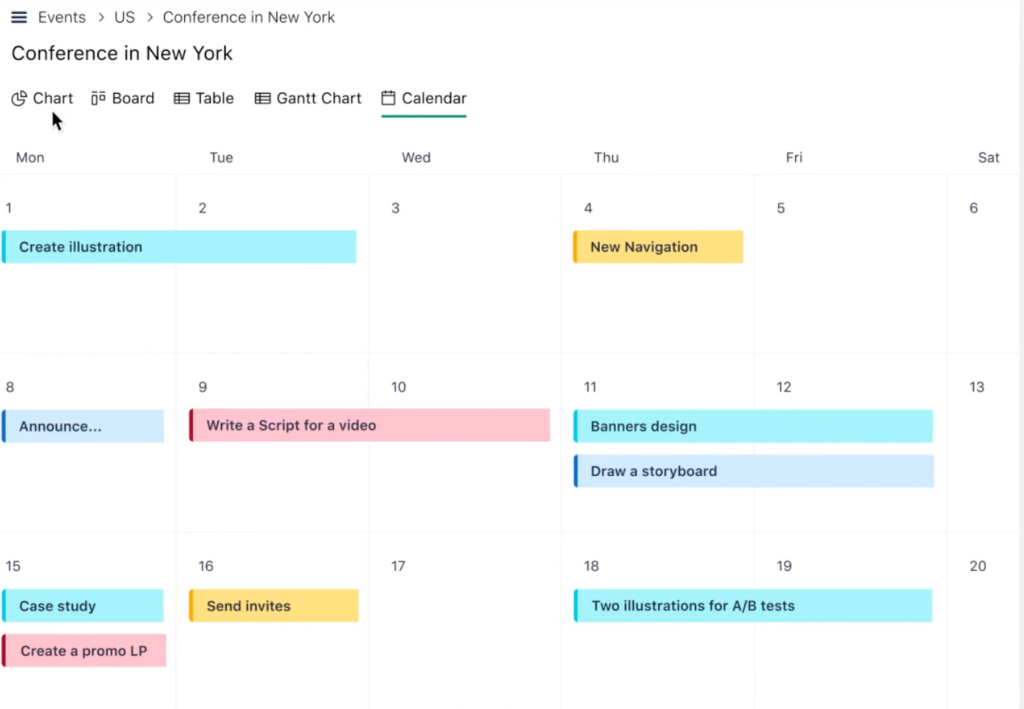
Which Features Can You Access in the Free Plan?
- Unlimited Users, to collaborate with an unrestricted number of team members.
- Task and Subtask Management, to organize work efficiently.
- Board and Table Views that help you visualize tasks using Kanban-style boards or spreadsheet-like tables.
- Real-time Activity Stream that keeps you updated with live notifications of project activities and changes.
- Email Integration, allowing you toonvert emails into tasks and manage them within Wrike.
Paid Plans
Small teams looking for advanced features would need to go beyond the free Kanban board software and subscribe to Wrike’s Team plan, priced at $10 per user per month. This plan includes unlimited projects, tasks, and subtasks, custom fields, request forms, interactive Gantt charts, custom workflows, and 2 GB of storage per user.
If your team counts more than 15 people you’ll need to upgrade to the Business plan which is available at $24.80 per user per month. It accommodates up to 200 users and adds features like nested projects, cross-tagging, project blueprints, custom item types, 5 GB of storage per user, reports, time tracking, and dashboards.
Wrike’s more expensive Enterprise and Pinnacle plans include advanced security, scalability, and analytics tools. Pricing for these plans is available upon request.
ClickUp – Comprehensive Project Management
Helps you streamline your workflow across all departments.
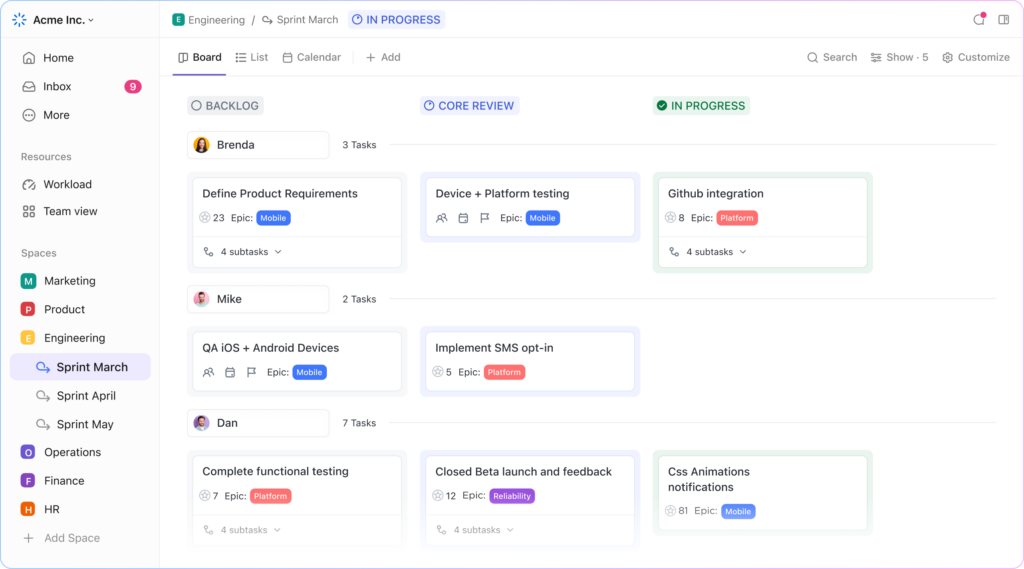
Which Features Can You Access in the Free Plan?
- Unlimited Tasks to create and manage an unrestricted number of tasks to organize your work.
- Unlimited Members, allowing you to collaborate across your entire organization
- Two-Factor Authentication to enhance security.
- Collaborative Docs where you can create and edit documents collaboratively within the platform.
- Whiteboards for brainstorming and visual collaboration.
- Everything View, so you can visualize all tasks and projects in one place.
Paid Plans
The next tier after ClickUp’s free Kanban board software plan is the Unlimited plan. It costs $7 per user per month and should suit most startups as it provides unlimited storage, integrations, dashboards, Gantt charts, and custom fields. You will also be able to access advanced reporting and time tracking features.
If you upgrade to the Business plan, costing $12 per user per month, you will also be able to use advanced automation capabilities, goal tracking, portfolios, and custom exporting options. It also offers enhanced security features such as Google Single Sign-On (SSO) and two-factor authentication, catering to organizations that require more sophisticated data security.
Finally, there’s the Enterprise plan, which includes all features alongside advanced permissions, unlimited custom roles, and dedicated support. Pricing for the Enterprise plan is available upon request.
KanbanFlow – Simple Tool with WIP
Helps your team get more done with time-tracking Kanban boards for focused teams.
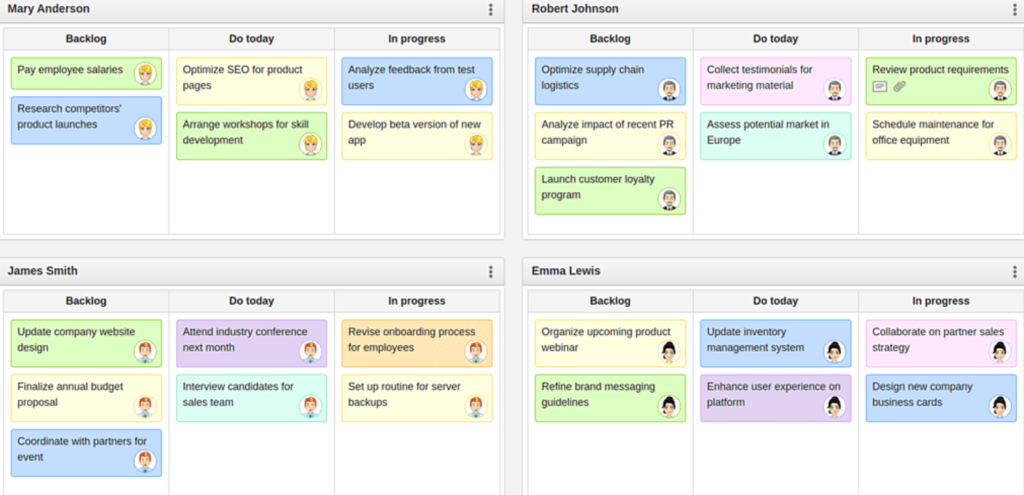
Which Features Can You Access in the Free Plan?
- Unlimited Boards & Tasks to manage the workflow according to your preferences
- Subtasks to make project management easier.
- Filters for a more organized workflow.
- Recurring Tasks so as to maximize time management.
Paid Plans
Beyond its free Kanban board software, KanbanFlow offers one paid pricing plan at $5 per user per month with a 10% discount for annual payments. This includes all features of the Free plan and adds advanced analytics and reporting tools such as cumulative flow, cycle and lead time, burndown, throughput, calendar, due date performance, dashboard, Monte Carlo forecasting, revision history, time estimate reports, and task count reports.
The paid plan also offers integrations with Excel and CSV import, task addition via email, API and webhooks, calendar feed/iCal, Zapier, Dropbox, Google Drive, OneDrive, and Box. Enhanced security and control features include two-factor authentication, view-only permission roles, and custom permission roles.
Kanban Tool – Customizable & Integrations-Ready
Makes it easy to visualize workflows and boost productivity with basic boards.
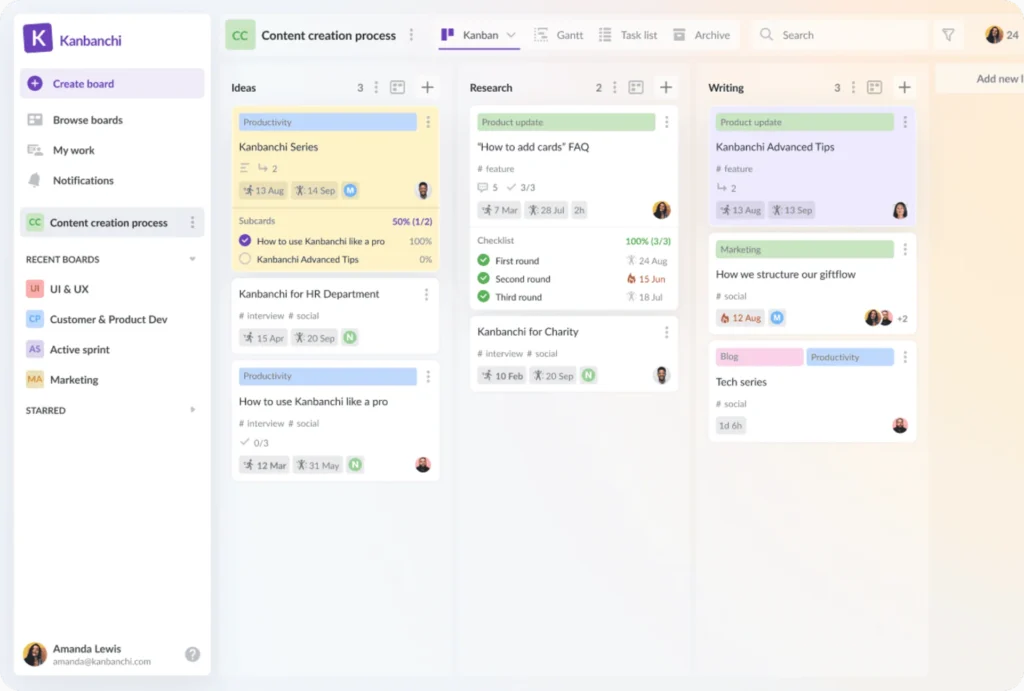
Which Features Can You Access in the Free Plan?
- Work-In-Progress (WIP) Limits to optimize workflow and prevent bottlenecks.
- Subtasks, allowing you to break down tasks into smaller, manageable subtasks to monitor progress effectively.
- Easily filter tasks by user, label, color, or due date to focus on specific items.
- Set Recurring Tasks to repeat at specified intervals, eliminating the need to recreate them manually.
Paid Plans
Requirements that involve more than two users and two boards don’t qualify for this free Kanban board software, so you’ll need to upgrade to the Team Plan. Priced at $6 per user per month, this offers unlimited boards and file attachments and is suitable if your team is seeking to scale up operations with more comprehensive features.
At the higher end of the scale there’s also the Enterprise Plan, costing $11 per user per month. This option gives you a range of advanced functionalities such as time tracking and reporting, user groups management, and process automation.
Monday.com – Enables Deep Collaboration
Customizable and easy project management for your team.
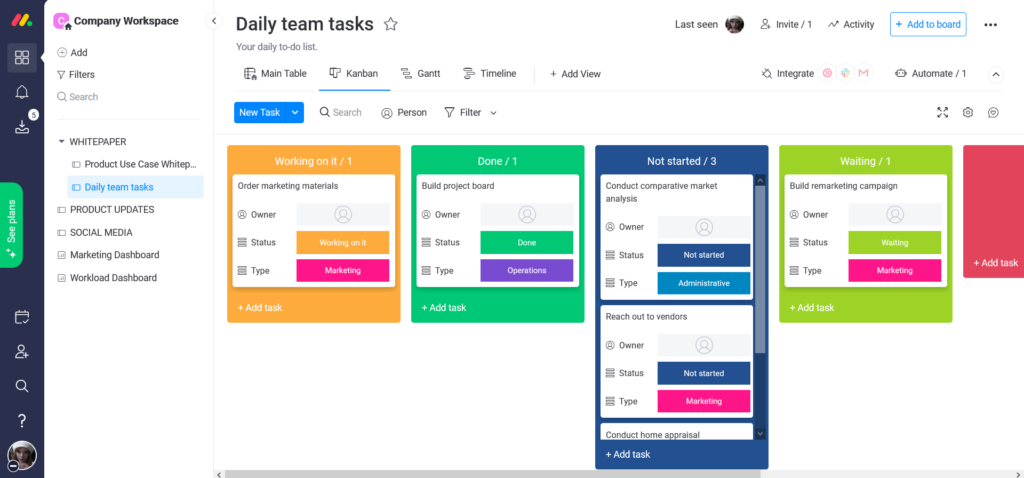
Which Features Can You Access in the Free Plan?
- Up to 2 users for work collaboration.
- Up to 3 boards with unlimited docs and a set number of templates.
- iOS and Android App Compatibility so you can manage your work on the go.
- 500 MB of File Storage & Unlimited Free Viewers allowing you to share your boards at no additional cost.
Paid Plans
Starting at $8 per seat per month, the Basic plan offers prioritized customer support, and the ability to create a dashboard that combines up to 1 board. This plan is designed for small teams that need to go beyond the free Kanban board software capabiities.
Medium-sized teams would fare better on the Standard Plan, costing $10 per user per month. The plan adds a timeline and Gantt views, calendar view, guest access, automations (250 actions per month), integrations (250 actions per month), and the ability to create a dashboard that combines up to five boards.
If you need more boards you’ll need to fork out $16 per seat per month, with private boards and docs, chart view, time tracking, formula column, dependency column, more automations (25,000 actions per month) and integrations (25,000 actions per month), and the ability to create a dashboard that combines up to 10 boards.
Jira – Focused on Scrum
Built for agile teams to plan, track, and release like a pro.
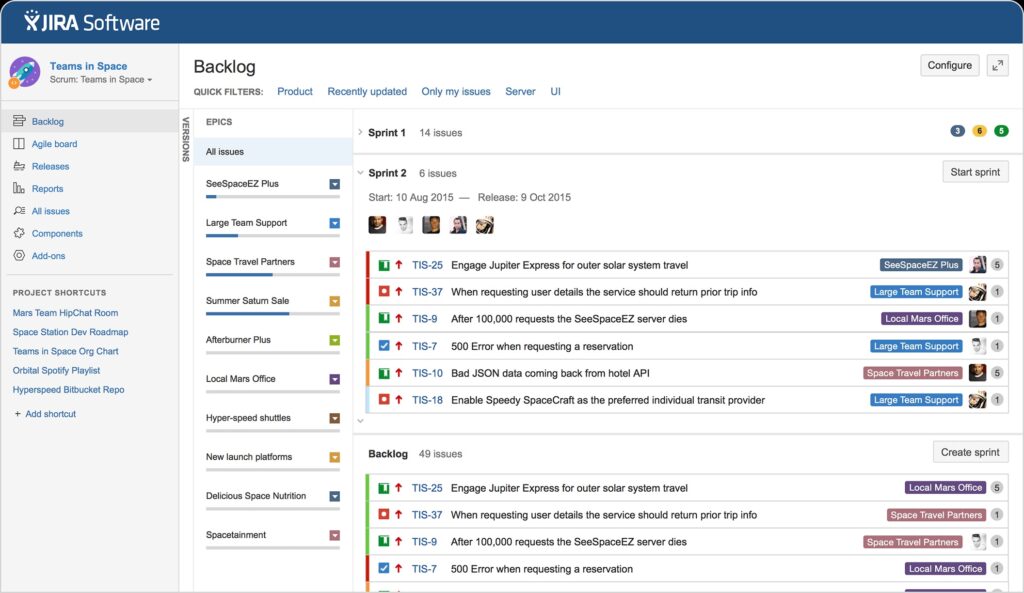
Which Features Can You Access in the Free Plan?
- Up to 10 Users, ideal for medium-sized teams.
- Unlimited Scrum & Kanban Boards to manage workflows.
- Basic Customizable Workflows, allowing you to tailor issue statuses and transitions to fit your team’s processes
Paid Plans
At $7.75 per user per month, the Standard plan accommodates up to 35,000 users and offers 250 GB of storage and includes advanced permissions, project roles, audit logs, and data residency options.
The Premium plan is priced at $15.25 per user per month and adds unlimited storage, advanced roadmaps, sandbox environments, release tracks, and 24/7 support.
What is a Free Kanban Board Software?
A free Kanban board software helps you organize tasks visually without it being a burden on your organization’s budget. At its very basic, free Kanban Board software offers a digital version of a whiteboard filled with sticky notes. Each note represents a task, but it’s not cluttering your desk and it can be shared with other members of your team, other departments and – with the really best free Kanban boards – even externally.
The app allows you to create columns like ‘To Do’, ‘In Progress’, and ‘Done’, and you simply drag tasks from one column to the next as work moves forward. It couldn’t be simpler, as it rids you of a never-ending list of emails or messages with requests and information that you can’t track.
The beauty of the best free Kanban board software lies in its simplicity. The whole team can keep track of what’s being worked on, who’s responsible, and what’s coming next. With a free version, you get some of the core features without the need for a subscription, making it an ideal starting point for small teams, freelancers, or anyone wanting to stay organized on a budget.
To put it in a nutshell, a free Kanban board software is all about staying organized, seeing the bigger picture of your workload, and making it easier to prioritize – all without opening your (virtual) wallet.
Why is a free Kanban Board Software the Best Tool for You?
Research has shown that using free Kanban board software helps increase the productivity and motivation of teams. Here’s how.
- Offers highly visual task management
- Is easy to use, with no steep learning curve
- Gives you instant progress tracking
- Includes flexible customization options
- No cost means no risk
- Helps boosts the whole team’s efficiency
Start Using Teamplate for Free Now
All you need to do is get in touch with our team for a full and free onboarding.
FAQs
Is there any free Kanban board?
Yes, Teamplate is a 100% free Kanban board software that offers access to all features without ever asking you to pay for an upgrade.
Does Google have a Kanban tool?
No, Google does not offer a native Kanban tool within its suite of applications. However, free Kanban board software like Teamplate offer comprehensive functionalities that you can use from within your Google profile.
Does Office 365 have a free Kanban board software?
Yes, Office 365 includes Microsoft Planner, a tool that offers Kanban board features. However, the free plan offers limited access to plans and task management and workflow.
Is Trello Kanban free?
Trello offers a free Kanban board software tier that provides basic Kanban board functionalities, including task creation, list organization, and collaboration features. However, if you’d like access to features like nesting, additional integrations, automation, and enhanced security options, you’ll need the paid plan.
Kanban boards are quite the buzzword when it comes to free process manamagement softwares for modern teams, mostly because they offer a visual and intuitive approach to task management.
Many of the top-rated tools are flexible and easy-to-use, but they can come at a hefty cost that discourages startups and organizations on a budget from subscribing. The best free Kanban board options give you free access, but advanced functionalities may come at a hidden (and often high) cost.
In this guide we delve deep into which Kanban boards deliver on their promise, combining full free access with efficient project management.
Table of Contents
What is a Kanban Board?
A free Kanban board can be described as a visual tool that helps your team organize work efficiently, leading to improved productivity and smoother workflows. To explain it in its simplest format, a Kanban board represents the flow of tasks through different stages, typically organized in columns like ‘To Do’, ‘In Progress’, and ‘Done.
Tasks are represented by cards that can be moved from one column to the next, giving a clear, visual overview of progress. The system is very simple, but powerful, allowing you and your team to instantly understand what’s pending, who’s responsible, and what has been completed.
Having access to a free Kanban board is useful no matter what level you are in the hierarchy. Whether you’re a team lead, a C level, a head of department or even an external freelancer, the tool will help you keep on top of your workload and see where you fit in the larger picture. It keeps everyone on the same page without the need of meetings, updates or much effort.
The Best Free Kanban Boards at a Glance
| Feature | Teamplate | Pipify | Kanban Flow | Asana | ClickUp | Kanban Tool | Miro | Monday.com | Taskworld |
| Free Plan | Unlimited free plan including all functionalities | Up to 10 users | No file attachments, analytics, integrations or customizations | Up to 15 users | Up to 5 spaces | No file attachments, time tracking or automation | Up to 3 boards | Up to 2 users, basic functions only | Up to 1GB storage & 15 users |
| Visual Workflow | Yes | Yes | Yes | Yes | Yes | Yes | Yes | Yes | Yes |
| Task Cards | Yes | Yes | Yes | Yes | Yes | Yes | Yes | Yes | Yes |
| Customizable Columns | Yes | Yes | Yes | Yes | Yes | Yes | Yes | Limited | Yes |
| WIP Limits | Yes | Yes | Yes | No | Yes | Yes | No | No | Yes |
| Real-Time Collaboration | Yes | Yes | Yes | Yes | Yes | Yes | Yes | Yes | Yes |
| Analytics & Reporting | High | High | Low | High | High | Moderate | Moderate | Low | High |
| Dashboard Integrations | Email, Calendar, Chat, Video Conferencing, Screen Recording, Project Management, | Chat, Email, | Google Calendar, Slack | Slack, Google Drive, | Slack, Google Drive, Calendar | Email, Slack, Zapier | Google Drive, Slack, | Microsoft Teams, OneDrive, Calendar | Slack, Email, Calendar, Google Drive |
| Ease of Use | Intuitive | Intuitive | Intuitive | Difficult | Moderate | Moderate | High | Moderate | High |
| Task Prioritization | Yes | Yes | Yes | Yes | Yes | Yes | Yes | Yes | Yes |
| Automated Notifications | Yes | Yes | Yes | Yes | Yes | Yes | Yes | Yes | Yes |
Top Free Kanban Board Tools – Detailed Reviews
Want to learn more about the free Kanban board tools listed above, and why they made it on our list. Below, our experts have compiled more detailed reviews that are the result of practical testing on a number of mock projects.
Teamplate

Rating: ⭐⭐⭐⭐⭐
A fully-integrated Kanban-style platform that is entirely free.
What you get in a nutshell:
Teamplate is an all-in-one project management tool that provides a range of features without any cost, making it an ideal solution if you’re looking for comprehensive task management and collaboration capabilities. Unlike many competitors, Teamplate is an actual free Kanban board with no hidden costs. It offers all features at no cost, making it highly accessible to teams of any size.
Pros:
- 100% free: Teamplate provides access to all its features at no cost, allowing teams to use the full range of capabilities without needing to upgrade or pay for premium versions.
- Integrated platform: The tool combines project management, task tracking, time tracking, and team communication in a single platform, reducing the need for multiple applications.
- Visual task boards: Kanban-style boards make it easy to organize, prioritize, and track the progress of tasks and projects visually.
- Built-in communication tools: Integrated chat and messaging features make it easy for the entire team to collaborate and communicate without relying on external apps.
- Customizable templates: You can set up projects quickly and tailor them to the specific needs of your team.
- Time tracking: The built-in time tracking feature helps you monitor the time spent on tasks, improving accountability and productivity.
- Real-time updates: All team members are always on the same page, fostering better coordination and productivity.
Cons:
- Limited third-party integrations: Teamplate is designed to be a standalone platform that covers all communication needs (chat, email, video-conferencing, screen recording) and project management, so the focus is not on integrating with other external tools.
Best use cases:
Teams looking for a free Kanban board without the need to pay for advanced features, especially those who prefer an integrated platform that handles task management, communication, and time tracking all in one place.
Verdict:
Teamplate is a standout digital management tool, especially for teams looking for a no-cost solution with a rich set of features. The all-in-one approach makes it highly convenient, and the intuitive dashboard doesn’t require a steep learning curve.
Pipify
Rating: ⭐⭐⭐☆
A free Kanban tool with powerful automation for small teams.
What you get in a nutshell
Pipefy is one of the best project management tools for startups, featuring a customizable Kanban board, making it suitable for visually organizing tasks while also incorporating automation for more efficient workflows.
Pros:
- Customizable Kanban board: You can carry out drag-and-drop customization, making it easy to adapt to specific workflow requirements without advanced setup.
- Built-in automation: Automation rules are accessible even in the free version, so you can automate routine tasks, such as moving cards or updating fields based on triggers.
- Ready-to-use templates: Pipify provides pre-designed templates for processes like recruitment, onboarding, and task management, which speeds up the setup process.
Cons:
- Limited field customization in free plan: The free version restricts customization of fields and card properties, which you’ll probably find too
- limiting for more complex processes requiring specific data.
- Basic Analytics: The reporting features do not allow for deep analysis or customized data views, so you won’t be able to extract actionable insights from workflow performance.
Best use cases:
Small teams or startups looking for a straightforward, free Kanban board with added automation features.
Shortcomings:
Pipefy’s free plan lacks advanced integration options with other major productivity tools, which can hinder your workflow if you’re using a range of platforms. Additionally, the limited custom field options make it difficult to adapt to workflows that require highly specific data tracking.
Verdict:
Pipefy is an excellent choice if you’re looking for a simple, but efficient, free Kanban board with built-in automation. But if you need in-depth analytics or advanced customization it comes at a cost.
Kanban Flow

Rating: ⭐⭐⭐☆
A simple yet effective Kanban tool with integrated time tracking.
What you get in a nutshell:
Kanban Flow is a lightweight Kanban project management tool that integrates time-tracking features, perfect if you need to enhance personal productivity or manage small team projects efficiently.
Pros:
- Time tracking integration: Built-in Pomodoro timer and time-tracking capabilities help you monitor how long tasks are taking.
- Swimlanes for enhanced organization: You can organize tasks into categories, making complex workflows more manageable.
- Task dependencies: This ensures that tasks are completed in the proper order, which reduces workflow bottlenecks.
Cons:
- Limited integration options: KanbanFlow has very few integrations with other productivity or communication tools, making it challenging to use within a broader software ecosystem.
- No mobile app: Lacks a dedicated mobile app, so if you often need to manage tasks on-the-go it may not be the right solution for you.
Best use cases:
Individuals or small teams that need a straightforward Kanban board with effective time-tracking features.
Shortcomings:
KanbanFlow lacks more sophisticated reporting and analytics features, so it’s less suitable if you’re running a larger team that needs data-driven insights. Functionalities aren’t integrated in one hub, so you’ll need to deal with different platforms.
Verdict:
KanbanFlow lives up to its description as a free Kanban board and is a great tool for personal productivity, but the lack of advanced features, including integration and analytics, means it’s not ideal for largescale or complex projects.
Asana
Rating: ⭐⭐⭐⭐☆
A robust task management tool for teams of all sizes with powerful project tracking features.
What you get in a nutshell:
Asana’s versatility makes it one of the best online collaboration platforms, offering a mix of task management, project planning, and team collaboration tools. Its combination of customizable workflows and easy-to-use interface makes it well-suited for teams ranging from small startups to large enterprises.
Pros:
- Customizable workflows: You can tailor these to fit a wide range of project needs, from simple task lists to complex project timelines.
- Multiple project views: Choose from list, board, calendar, and timeline, so as to visualize projects in a way that best suits your workflow.
- Integration with popular tools: You can combine it with a vast number of third-party tools, such as Slack, Google Workspace, and Microsoft Teams.
Cons:
- Limited free plan features: This is far from being a 100% free Kanban board, and many advanced features – like timeline view and task dependencies – need to be paid for. This will limit its use for larger teams.
- Difficult to master: The number of features can be overwhelming for new users, leading to a longer onboarding process.
Best use cases:
Teams needing to track complex projects with multiple tasks and wanting the flexibility of a free Kanban board with different visualization tools to manage work effectively.
Shortcomings:
The notification system can be overwhelming, especially for larger teams, leading to potential missed updates or alert fatigue. The absence of built-in time tracking means users may need third-party integrations to manage task durations effectively.
Verdict:
Asana is an excellent project management tool for teams looking for a robust solution to track tasks, projects, and team communication. If you’re looking for the best free online collaboration tools you also need to be very aware that most functionalities require payment.
ClickUp
Rating: ⭐⭐⭐⭐☆
Offering extensive customization options.
What you get in a nutshell:
This is a comprehensive management and productivity platform designed to meet the needs of teams of all sizes. It comes with a vast range of features and customization options, to help you manage tasks, workflows, goals, and projects in one space.
Pros:
- Highly customizable: There are extensive options for views, fields, and workflows, allowing you to tailor your platform to your unique needs.
- Multiple task views: You can switch between list, board, Gantt, and more, so you decide how you want to organize your projects.
- Native time tracking: You can monitor your team’s progress without needing third-party tools.
Cons:
- Complex interface: The extensive features and customization options can make ClickUp’s interface feel cluttered, leading to a steeper learning curve.
- Limited mobile functionality: Some functionalities that are present in the desktop version are absent on mobile.
Best use cases:
Teams that need a highly customizable project management tool.
Shortcomings:
This free Kanban board has a vast number of features, but these can lead to overcomplication, making it challenging for smaller teams or those looking for a straightforward tool.
Verdict:
Aversatile and powerful project management tool, particularly suitable if you like having a wide range of features in one platform. However, smaller teams may prefer a simpler, more streamlined interface.
Kanban Tool
Rating: ⭐⭐⭐☆
A simple and effective visual management tool with real-time collaboration.
What you get in a nutshell:
The OG, the Kanban Tool is a straightforward project management platform that focuses on visual task management through Kanban boards. This free Kanban board is simple and intuitive and was created specifically for teams seeking real-time collaboration without the clutter of excessive features.
Pros:
- Real-time collaboration: Your team can view changes as they happen, which improves transparency and coordination.
- Swimlanes for organization: Users can create swimlanes to categorize tasks, which is very helpful in manageing different workflows and prioritizing projects visually.
- Time tracking add-on: You can choose to add a time tracking add-on to gain insight into how long tasks take and help your productivity analysis.
Cons:
- Limited integration options: This places it at a disadvantage for interconnected workflows.
- Very basic analytics: Reporting features are quite simple, which may not be sufficient for teams needing in-depth insights.
Best use cases:
Small teams or individuals who would like a visual way to manage tasks and projects, with minimal setup and straightforward features.
Shortcomings:
The lack of realintegration options will be a weakness if your team relies on multiple software tools. Additionally, the platform’s simplicity, while viewed as an advantage by some, may not provide enough advanced features if you’re part of a larger team with more complex project needs.
Verdict:
This free Kanban board offers an effective a simple solution for visual task management, but its limited integrations and basic analytics make it less suitable for larger or more feature-demanding teams.
Miro
Rating: ⭐⭐⭐⭐☆
A versatile online collaborative whiteboard for brainstorming and visual project planning.
What you get in a nutshell:
Miro is a flexible online collaborative whiteboard platform that will help you brainstorm, plan projects, and visualize workflows via its free Kanbard board functionalities. Its intuitive interface and wide range of features make it ideal for creative teams and those who need a collaborative visual space to ideate and plan.
Pros:
- Versatile templates: You’ll find a wide selection of pre-built templates for brainstorming, mind mapping, retrospectives, and more, to get you started off quickly.
- Real-time collaboration: Multiple members of your team can work on the board simultaneously.
- Integration with popular tools: There’s a variety of tools like Slack, Google Workspace, Jira, and Microsoft Teams that can be incorporated into existing workflows.
Cons:
- Difficult to get used to: Due to its extensive features and flexibility, it can be overwhelming to learn and navigate at first.
- Performance issues with large boards: Some users have reported performance slowdowns when working with very large or complex boards/
Best use cases:
Teams that need a collaborative space for visual brainstorming, mind mapping, and planning, especially in the context of remote team collaboration tools.
Shortcomings:
Its very flexibility can lead to overcomplication, especially if you only need a simple, structured workflow without too many options. Additionally, setting up the many integrations, setting them up can be time-consuming, especially for less tech-savvy users.
Verdict:
Miro is a powerful collaborative tool if you need a visual, flexible space to brainstorm, plan, and innovate. Its versatility and real-time collaboration capabilities are its main strengths, but the learning curve and potential performance issues may be a drawback for some users.
Microsoft Planner
Rating: ⭐⭐⭐☆
A simple task management tool integrated with Microsoft 365.
What you get in a nutshell:
Microsoft Planner is a task management tool that integrates seamlessly with the Microsoft 365 ecosystem, providing a simple way for you to create, assign, and track tasks. Its intuitive Kanban-style interface makes it easy to visualize project progress and to collaborate within the Microsoft environment.
Pros:
- Integration with Microsoft 365: Microsoft Planner is tightly integrated with Microsoft 365, allowing you to link tasks with tools like Teams, Outlook, and SharePoint.
- Easy task assignment and tracking: It’s ideal for basic project management and keeping your team organized at a basic level.
- Simple, visual interface: This free Kanban board provides an easy-to-use visual overview of tasks, which is particularly useful if you’re looking for a basic way to manage workload.
Cons:
- No advanced project management features: This limits its use for more complex project needs.
- Limited customization options for workflows and task details: This may reduce its effectiveness for teams that require more tailored solutions.
Best use cases:
Small to medium-sized teams that are already using Microsoft 365 and need a straightforward way to manage tasks and collaborate without the complexity of advanced project management tools.
Shortcomings:
The lack of advanced features means it struggles to handle complex projects, which makes it less viable if you’re part of a larger team or you work on intricate project timelines. Moreover, its limited reporting capabilities can make it challenging for managers to gather detailed insights into project performance.
Verdict:
Useful in terms of simple task management solutions within the Microsoft ecosystem, but unsuitable for managing complex projects.
Taskworld
Rating: ⭐⭐⭐⭐☆
A feature-rich project management tool with built-in performance tracking and visual task boards.
What you get in a nutshell:
Taskworld combines task organization with performance tracking, providing a comprehensive tool for managing tasks, collaborating, and gaining insights into productivity. It comes with a colorful and intuitive interface designed to help teams you stay organized no matter the size of your team.
Pros:
- Built-in performance tracking: You can easily track task completion rates and productivity without a third-party tool.
- Visual task boards: These make it easy to visualize progress, organize tasks, and track individual responsibilities.
- Chat and collaboration: Integrated chat and messaging allows you to communicate directly within the platform.
Cons:
- Limited field customization: The free version restricts customization of fields and card properties, which can be limiting for more complex processes requiring specific data.
- Basic Analytics: The reporting features do not allow for deep analysis or customized data views, so there’s no ability to extract actionable insights.
Best use cases:
Teams that need a free Kanban board with visual task boards and advanced communication tools.
Shortcomings:
Limited third-party integrations can be a drawback, while the platform’s pricing structure might not be the best fit for small businesses or startups that are looking for a budget-friendly option with advanced features.
Verdict:
A well-rounded project management tool with visual task boards that’s ideal for mid-sized to larger teams. However, if you’re after an actual free Kanban board, higher pricing for advanced features may be challenging for smaller teams or those with complex software needs.
How We Evaluate and Test Apps
To ensure we recommend only the best free Kanban tools, we use a data-driven process where we evaluate each app based on a number of key criteria.
These are the main features that will determine whether the tool provides a positive experience for members of the team while being a worthwhile addition to your organization as a whole.
- Affordability: We have only included a tool if it offers a free Kanban board functionality beyond a free trial. The majority don’t give you access to all features for free, but you will at least have a basic level accessible without the need to pay a subscription.
- Customization: The best free Kanban board should be flexible, allowing you and each member to tailor workflows, boards and views to match your unique needs.
- Integration: Seamless integration with other essential tools like email, calendars, chat and video conferencing is crucial to avoid wasting time with multiple tools and to keep everyone aligned.
- Ease of Use: An intuitive interface is essential when picking a free Kanban board.Your team shouldn’t need to use up time and energy on onboarding tools as this impacts productivity.
- AI Automation: Features like AI-driven task assignment or priority setting can significantly boost both morale and productivity, letting your team focus more on meaningful work rather than repetitive tasks. Brownie points if these are easy to use and don’t require knowledge of coding.
What Makes the Best Free Kanban Tool?
Given all the above, the best free Kanban tool is one that adapts seamlessly to the specific needs of your team while remaining simple and efficient to use.
We view real-time collaboration, flexible visual customizations, insightful analytics, and smooth integrations as being essential features. So is the ability to maintain clear communication through easy tagging, comments, and automated updates.
How does a Free Kanban Board Improve Your Productivity & Team Workflows?
The right free Kanban board can provide a very powerful tool for boosting productivity and streamlining teamwork. By visualizing work as a series of manageable tasks, Kanban makes it easy for your team to see priorities and deadlines at a glance. This visual clarity reduces miscommunication and prevents tasks from falling through the cracks.
Additionally, the visual flow of tasks highlights where bottlenecks occur, allowing you to address issues before they become major obstacles. Your team is empowered to take responsibility, regularly moving tasks across the board according to each task owner’s progress. This encourages accountability and helps establish a rhythm of steady progress, fostering a culture of continuous improvement.
In short, an excellent, free Kanban board has the potential to transform your task management process into a visual, efficient, and collaborative experience, making complex projects feel more under control.
Is it worth doing the groundwork to find the best free Kanban tool? Undoubtedly. While figuring all this out may sound like a lot of effort, the comparison table we’ve provided above will give you answers to the most common questions at a glance. Once you have a basic understanding of the capacities of each app, you can use our detailed reviews to find out more information about specific functionalities.
Why Teamplate is the Best Free Kanban Board Creator
Starting with the obvious, Teamplate is 100% free. It comes at no cost at all and will allow you to access advanced capabilities without putting a strain on your budget. But it’s not just about costings – if you’re managing multiple projects you will undoubtedly find the visual task boards and customizable templates a huge help. The boards also make it easy to keep track of productivity and accountability thanks to the built-in time tracking feature, so it’s easy to monitor the way time is allocated across various projects and tasks.
Finally, the real-time collaboration and integrated communication tools are invaluable for keeping the workflow smooth without needing to switch between multiple applications.
How to Create a Free Kanban Board with Teamplate
- Start off by creating Spaces by topic – eg Tasks, Events etc
- Choose the Space where you want to create a project – let’s assume you’re picking Tasks
- Click on the 3 dots next to ‘Tasks’ and choose ‘Add project’
- Name your new project and create a prefix for easier filing
- Customize the project as you wish, with deadlines, tags, assignees etc
- Invite team mates to your project
And that’s it, your free kanban board is done! Ready to start using Teamplate for your team for free? Click here to hit the ground running.
Are you torn between Trello and Notion for your team’s project management needs? You’ve come to the right place.
Trello has been a trusted choice for teams that need a straightforward, visual method to organize tasks and projects. With its simple interface centered around boards, lists, and cards, Trello has earned the loyalty of millions of users worldwide, becoming a staple in project management.
Notion, although newer in the productivity software arena, is quickly making a name for itself with its versatility and innovative approach. It’s an all-in-one workspace that combines note-taking, task management, and project planning, making it a formidable contender in the realm of productivity tools.
But is either tool the perfect fit for your team? Or could there be a better option tailored to your specific needs? In this article, we’ll break down the strengths and limitations of both Trello and Notion—and introduce you to Teamplate, an alternative that could be the ideal solution for your team.
Table of Contents
Comparing Trello and Notion
Both Trello and Notion offer powerful solutions for task management and team collaboration. However, they differ significantly in design, features, and the types of users they cater to.
- Trello is a simple, visual tool designed to help teams organize tasks and projects. Its user-friendly approach with boards, lists, and cards makes it easy for teams to see their work at a glance and manage tasks efficiently.
- Notion is a multifaceted tool that adapts to a wide variety of project management and documentation needs. Whether managing simple tasks or complex projects, Notion provides a flexible structure that can be customized to fit any workflow.
The choice between these tools ultimately depends on your team’s specific needs, preferences, and how you like to work. Keep in mind, there isn’t a universal solution for productivity software. If you find it difficult to decide between Trello and Notion, it’s worth considering that other tools might better suit your team’s unique requirements.
Let’s take a closer look at what Trello and Notion bring to the table by examining their key features, strengths, limitations, pricing, and user feedback. We’ll also introduce Teamplate, another powerful option that could be just what your team needs.
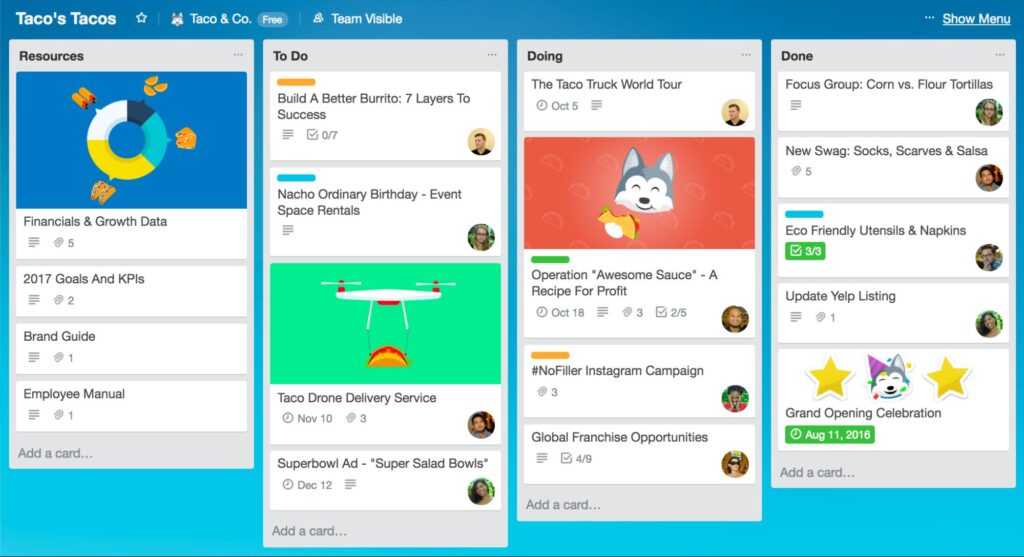
Trello Overview
Trello is a highly visual and easy-to-use project management tool that simplifies task management for teams of all sizes.
Key Features:
- Boards, Lists, and Cards: Visualize and organize your tasks and projects in a simple, intuitive way.
- Customizable Labels: Use color-coded labels to easily categorize and prioritize your work.
- Integrations: Enhance Trello’s functionality with integrations to a wide range of other tools.
- Butler Automation: Automate repetitive tasks with Trello’s built-in automation tool, Butler.
Best For:
- Teams that prefer a straightforward, visual approach to organizing tasks and projects.
- Small-to-medium teams looking for an uncomplicated, effective project management tool.
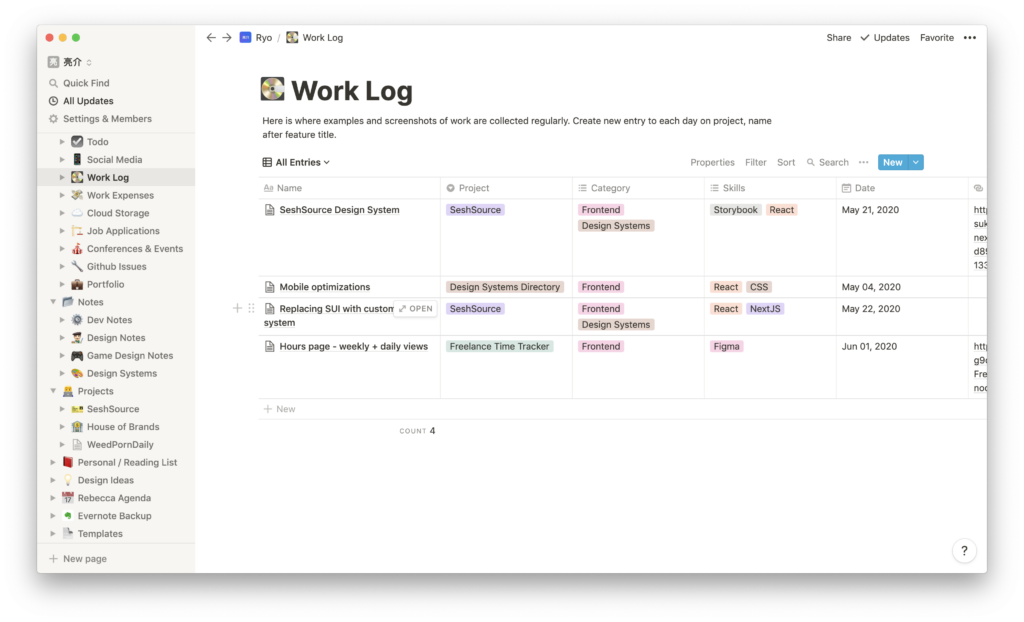
Notion Overview
Notion is a versatile tool that combines project management, documentation, and note-taking into one powerful platform.
Key Features:
- Project Dashboards: Customize dashboards to create a clear visual overview of your projects.
- Multiple Views: Manage tasks using lists, grids, calendars, and Kanban boards tailored to your needs.
- File Sharing and Collaboration: Work together on documents and share files seamlessly.
- Centralized Repository: Store and manage all your documents, SOPs, and handbooks in one easily accessible place.
Best For:
- Teams that need flexibility in managing both projects and extensive documentation.
- Small-to-medium teams that appreciate a highly customizable workspace.
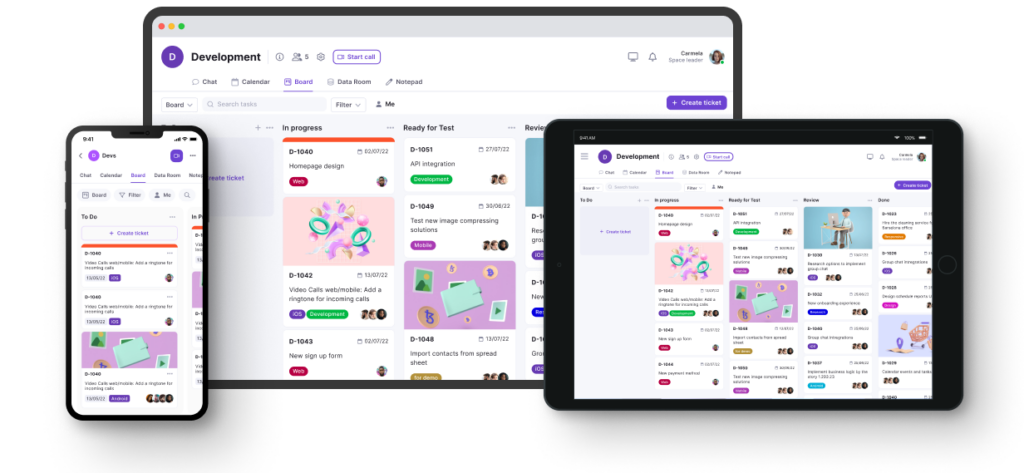
Introducing Teamplate: The Ultimate All-in-One Collaboration Tool
In the fast-moving world of project management and team collaboration, finding a tool that integrates all the necessary features can be challenging. That’s where Teamplate comes in—a user-friendly, all-in-one platform specifically designed for smaller-scale companies. Teamplate was created to rival industry giants like Slack, Zoom, Jira, and Confluence, by bringing together the best elements of these tools into a single, cohesive platform. This eliminates the hassle of switching between multiple apps, allowing you and your team to focus on what’s most important: getting work done.
Why Choose Teamplate?
- Increase Productivity: With Teamplate, you can consolidate your tools into one platform, reducing the need for constant switching between apps.
- Save Time & Money: Teamplate helps you streamline your workflow by bringing all your communication and project management tools under one roof, saving you both time and subscription costs.
- Empower Your Team: Facilitate effective collaboration with a unified platform that ensures all team interactions are connected and streamlined.

Teamplate’s Key Features:
- Chat: Communicate effortlessly with your team and clients across various projects and spaces.
- Video Calls: Conduct efficient meetings with built-in video call functionality, perfect for remote collaboration.
- Screen Recording: Capture and share important discussions with screen recording capabilities that integrate directly into your projects.
- Kanban Boards: Organize tasks, manage workflows, and track progress with customizable Kanban boards, epics, and sprints.
- Calendar: Keep your schedule in check and manage meetings with ease using the integrated calendar.
- Data Room: Securely store, upload, and share files of various formats with controlled access.
- Wiki & Notes: Store and share key ideas, meeting notes, and important information with your team using the Wiki feature, and keep your personal notes organized with the Notes feature.
- Dashboard: Get a clear overview of your tasks, events, and data from a centralized dashboard that keeps everything in one place.
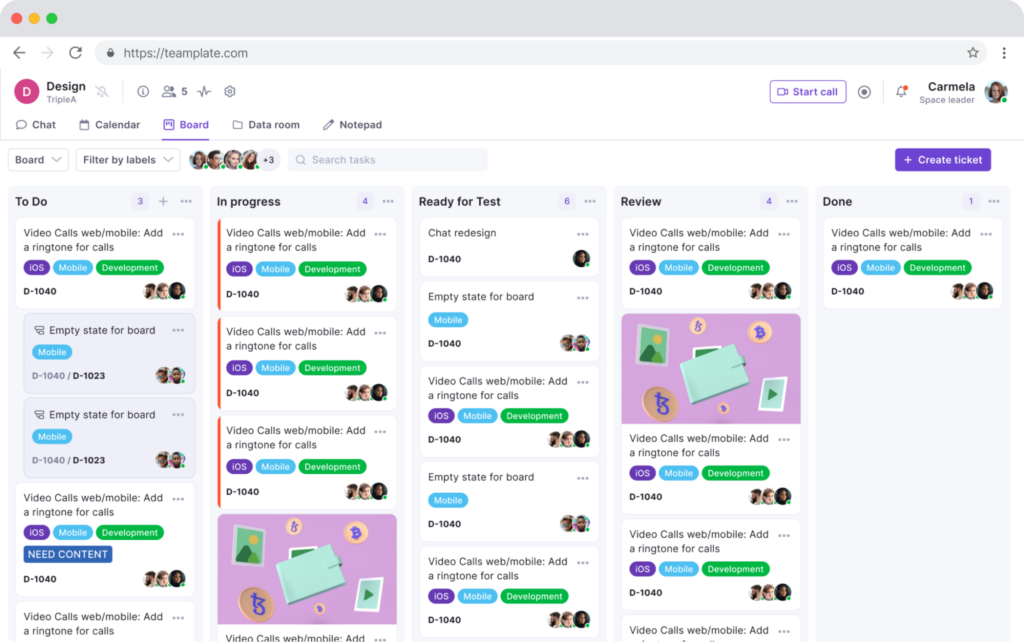
Trello vs Notion: Which Tool Should You Choose?
When it comes to choosing between Trello and Notion, the best choice depends on your team’s specific needs and the type of projects you handle.
- Trello: Ideal for teams that need a simple, visual tool to manage tasks and projects. It’s especially suited for smaller teams or those who prefer a straightforward project management solution.
- Notion: Perfect for teams that require a versatile tool capable of handling both project management and documentation. If your team values customization and flexibility, Notion might be the right fit.
However, if you’re looking for a solution that combines the best features of both tools—without the need for multiple apps—Teamplate could be the optimal choice. Teamplate offers the flexibility and collaborative features of Notion, along with the project management capabilities of Trello, all within a single, intuitive platform.
Why Teamplate Might Be the Best Choice
- All-in-One Solution: Unlike Trello and Notion, which may require additional integrations to reach their full potential, Teamplate provides a complete suite of tools in one platform, reducing the need for context switching and simplifying your workflow.
- Seamless Collaboration: With integrated features like chat, video calls, screen recording, and Kanban boards, Teamplate delivers a smooth communication and project management experience that keeps your team focused and connected.
- Cost-Effective: Teamplate’s freemium model ensures you get all the essential features without the need for multiple costly subscriptions, making it a more affordable option for small-to-medium teams.
Ultimately, the best tool for your team depends on what you value most. If you need a simple, visual organizer, Trello is a great option. If you prioritize flexibility and customization, Notion is a solid choice. But if you want an all-encompassing platform that reduces complexity and boosts productivity, Teamplate might just be the perfect fit.
Remote work is on the rise! However, the freedom it offers brings the challenge of maintaining team connection and productivity. That’s where the best collaboration tools for remote teams come into play. Think of these tools as your digital partners, bridging the physical gap, ensuring seamless communication, and efficient project management. From task management to idea brainstorming and staying connected, the right collaboration tools for remote teams can make your remote team feel as cohesive as an in-office team. This guide will help you navigate the top collaboration tools for remote teams. We’ll delve into the features, benefits, and pricing of each tool, helping you select the best fit for your team’s needs.
Table of Contents
Finding the Right Fit: Choosing Collaboration Tools for Remote Teams
Choosing the best collaboration tool for your remote team can be overwhelming with so many options available. But don’t worry, we’ve got you covered!
Identify Your Team’s Needs
Before diving in, take a moment to evaluate your team’s specific requirements:
- Team Size: How large is your team?
- Project Nature: What types of projects do you handle?
- Preferred Communication: How does your team prefer to communicate and collaborate?
Essential Features to Consider
Communication:
- Instant Messaging: Keep everyone connected with real-time chat.
- Video Meetings: Conduct virtual meetings, presentations, and team-building exercises.
- File Sharing: Collaborate on documents, presentations, and other files seamlessly.
Project Management:
- Task Management: Assign tasks, set deadlines, and track progress visually.
- Automation and Workflows: Streamline repetitive tasks to boost efficiency.
- Project Dashboards: Get real-time insights into project progress and performance.
Collaboration Tools:
- Shared Documents and Annotations: Work together on documents and provide instant feedback.
- Visual Brainstorming Tools: Capture ideas and collaborate using digital whiteboards.
- Discussion Forums: Share knowledge, ask questions, and foster team discussions.
Additional Factors:
- Tool Integrations: Ensure the tool integrates with your existing software, like calendars and email.
- Security and Privacy: Choose a tool that prioritizes data protection and privacy.
- User-Friendliness: Make sure the tool is easy to use for all team members, regardless of their technical skills.
- Scalability: Select a tool that can grow with your team.
Remember, the ideal collaboration tool is the one that aligns best with your team’s unique needs. Take your time, conduct thorough research, and get ready to enhance your team’s productivity and collaboration!
Best Collaboration Tools for Remote Teams in 2024

Trello: Your Visual Collaboration Playground
Trello transforms ideas into reality with its visual approach to project management. Imagine a digital board filled with sticky notes, but with powerful features and enhanced functionality. Trello is simple, intuitive, and infinitely customizable, making it ideal for teams of all sizes who need to organize their work, track progress, and collaborate effortlessly.
Features:
- Boards, Lists, and Cards: Organize your projects with boards, structure workflows with lists, and manage tasks with cards.
- Drag-and-Drop Functionality: Easily move cards to reflect progress and priorities.
- Labels and Checklists: Use labels for categorization and checklists for detailed task tracking.
- Comments and Attachments: Share ideas, ask questions, and attach files directly to cards for streamlined collaboration.
- Tool Integrations: Connect Trello with your favorite apps like Slack, Google Drive, and Dropbox for a seamless workflow.
Benefits:
- Enhanced Team Communication: Keep everyone in the loop with real-time updates and shared information.
- Transparency and Accountability: Visualize project progress and individual responsibilities to ensure everyone is aligned and accountable.
- Increased Productivity: Optimize workflows, eliminate bottlenecks, and accelerate task completion.
- Boosted Morale and Engagement: Make work engaging and interactive with Trello’s visual and user-friendly interface.
- User-Friendly: Trello is easy to learn and use, even for non-technical team members.
Pricing:
- Free Plan: Trello’s free plan offers unlimited cards, lists, and members, perfect for small teams or individuals starting out.
- Standard Plan: At $5 per user per month, this plan includes all free plan features plus unlimited boards and advanced checklists.
- Premium Plan: For $10 per user per month, get all Standard plan features along with unlimited guests and multiple view options.
- Enterprise Plan: Designed for large teams, this plan includes all Premium features plus advanced board management and power-ups.
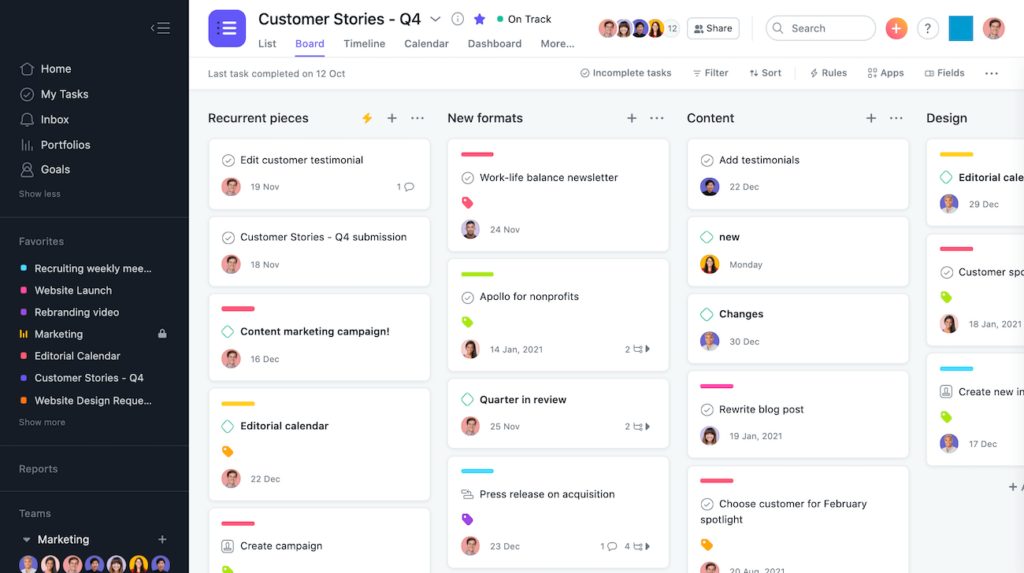
Asana: Your Ultimate Project Management Command Center
Asana is a robust solution for managing projects, assigning tasks, and keeping your team on track. Think of it as a command center where you can visualize progress, streamline workflows, and meet deadlines with confidence. Asana offers the structure and flexibility needed to stay organized and achieve your goals.
Features:
- Break Down Projects into Manageable Tasks: Create tasks with clear descriptions, due dates, and assignees to simplify large projects.
- Assign Tasks and Track Progress: Monitor who is working on what and see real-time progress to keep everyone informed and aligned.
- Visualize Timelines and Dependencies: Use Gantt charts to view project timelines and identify task dependencies, ensuring no steps are missed.
- Collaborate with Comments and Attachments: Discuss tasks, share ideas, and attach files directly to tasks for smooth collaboration.
- Automate Repetitive Tasks: Implement “Rules” to automate repetitive tasks like assigning due dates or adding tasks to specific projects, freeing up time for more important work.
- Tool Integrations: Connect Asana with apps like Slack, Google Drive, and Dropbox for a cohesive workflow.
Benefits:
- Increased Productivity and Efficiency: Achieve faster results with clear task management and automated workflows.
- Improved Communication and Collaboration: Enhance team communication and keep everyone updated with real-time information.
- Enhanced Project Planning and Execution: Break projects into manageable steps, track progress visually, and ensure timely completion.
- Scalability for Growing Teams: Asana adapts to your team’s evolving needs with flexible plans and features.
Pricing:
- Personal Plan: The free Personal plan includes unlimited tasks, projects, and collaborators, ideal for individuals and small teams starting with task management.
- Premium Plan: At $10.99 per user per month, this plan includes custom fields, advanced search and filtering, timeline view, and more.
- Business Plan: For $24.99 per user per month, the Business plan offers advanced workload management, portfolios with custom dashboards, and custom rules and automation.
- Enterprise Plan: Designed for large organizations, this plan includes all Business features plus a dedicated customer success manager, single sign-on, enhanced security, and more.
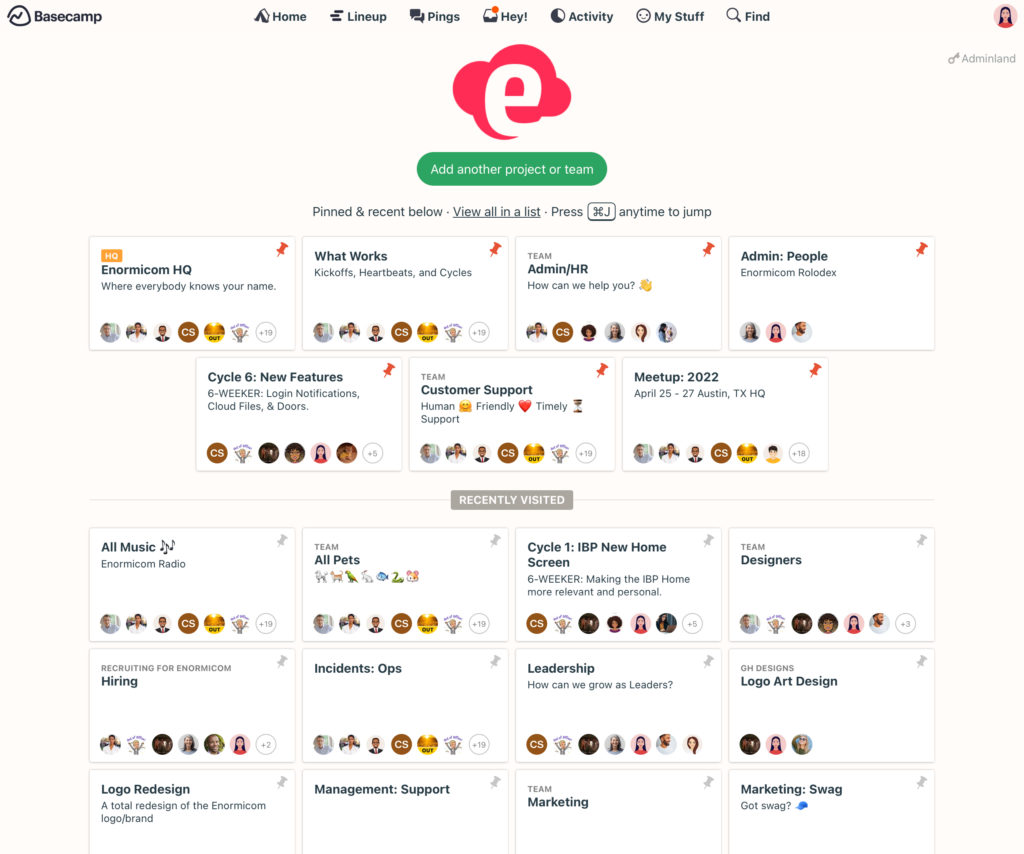
Basecamp: More Than Just Project Management
Basecamp is more than a tool; it’s a philosophy that emphasizes clear communication, focused collaboration, and a distraction-free environment to help your team thrive.
Features:
- Asynchronous Message Boards: Discuss projects, share ideas, and collaborate without the pressure of real-time interaction.
- To-Do Lists and Task Management: Track tasks, set deadlines, and prioritize work to ensure individual and team success.
- File Sharing and Document Collaboration: Share documents, work together on projects, and access information anytime, anywhere.
- Group Chat and Video Conferencing: Connect for real-time discussions when necessary.
- Popular Tool Integrations: Integrate with your favorite apps for a seamless workflow.
Benefits:
- Improved Focus: Minimize distractions to enhance focus and productivity.
- Clear Communication and Transparency: Foster open communication and keep everyone informed and aligned.
- Enhanced Accountability: Encourage teamwork by assigning responsibilities and tracking progress.
- Simplified Project Management: Keep everything organized in one place for better project oversight.
- Increased Flexibility and Work-Life Balance: Promote asynchronous communication and flexible schedules for a better work-life balance.
Pricing:
- Basecamp Personal: A free plan with limited features, ideal for individuals and freelancers.
- Basecamp Standard: $15 per user per month, includes 500GB of storage.
- Basecamp Business: $299 per month, a flat-rate plan for unlimited users and projects, with 5TB of storage.

ClickUp: Your Comprehensive Project Management and Collaboration Hub
ClickUp is your one-stop shop for all things project management and collaboration, designed to empower your team and streamline your workflow.
Features:
- Visualize Goals and Projects: Set clear objectives, define milestones, and track progress visually.
- Brainstorm and Plan with Mind Maps: Generate ideas, plan projects, and connect thoughts using visual mind maps.
- Customizable Boards, Lists, and Cards: Organize tasks, visualize workflows, and tailor the layout to fit your specific needs.
- Built-In Automation for Tasks: Automate tasks, set triggers and actions, and focus on strategic work.
- Integrate with Your Favorite Tools: Connect ClickUp to your preferred apps for a seamless and integrated experience.
Benefits:
- Improved Visibility and Control: Get a comprehensive view of your projects, identify bottlenecks, and make informed decisions.
- Top-Notch Communication and Collaboration: Ensure everyone is on the same page and work together efficiently with open communication.
- Increased Productivity and Efficiency: Streamline workflows, automate repetitive tasks, and achieve more in less time.
- Extremely Flexible and Scalable: Adapt ClickUp to your growing needs, whether you’re a small team or a large organization.
Pricing:
- Free Forever: Ideal for individuals and personal use.
- Unlimited: $7 per user per month, perfect for small teams and startups.
- Business: $12 per user per month, suited for growing teams and organizations.
- Enterprise: Custom pricing for advanced features and dedicated support.

Teamplate: Your Ultimate All-in-One Collaboration Tool
In the world of remote work and digital collaboration, Teamplate stands out as a user-friendly, comprehensive tool designed specifically for smaller scale companies. By integrating the best features of popular tools like Slack, Zoom, Jira, and Confluence, Teamplate eliminates the need for context switching, allowing users to focus on getting things done efficiently.
Key Benefits for Your Team:
Boost Productivity
- Focus on What Matters: With Teamplate, there’s no need to constantly switch between different apps. All your communication and project management tools are in one place.
- Streamlined Communication: Features like chat, video calls, and Kanban boards ensure that you can collaborate seamlessly without losing track of important conversations or tasks.
Save Time & Money
- Reduce Wasted Time: By consolidating multiple tools into one, Teamplate helps you find information quickly and reduces the time lost to context switching.
- Cost-Effective: Instead of paying for multiple subscriptions, you can access all the necessary features within Teamplate, leading to significant cost savings.
Empower Teams
- Unified Platform: With all your interactions happening in one place, Teamplate fosters a seamless collaboration environment, empowering your team to work more effectively.
Comprehensive Features:
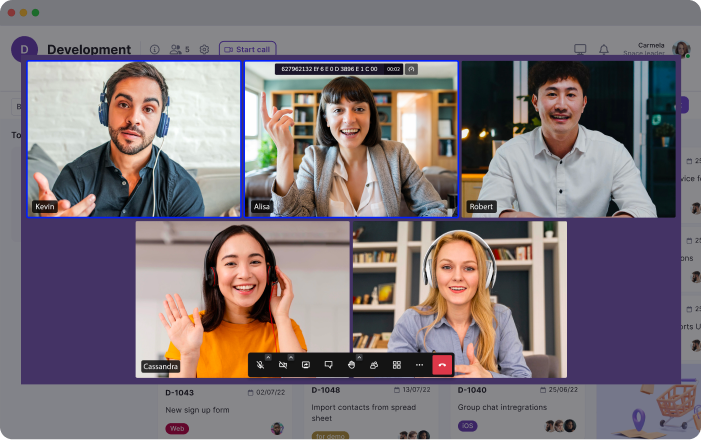
Communication
- Chat: Collaborate effortlessly with teams and clients across various projects, spaces, and direct messages. Real-time collaboration is enhanced with instant messaging, file sharing, and threaded conversations.
- Video Calls: Efficiently connect your team and clients for meetings and collaboration. Inbuilt screen recording and video call functionality unify remote teams and facilitate asynchronous communication.
- Screen Record: Easily record your screen and upload the recordings to chats, tickets, and the data room, ensuring everyone stays on the same page.

Project Management
- Kanban Boards: Organize workflows, manage tasks, and visualize progress with customizable boards, epics, and sprints. Switch between backlog, Kanban, and board views to suit your needs.
- Calendar: Manage your schedule and meetings effortlessly, keeping everyone aligned and on time.
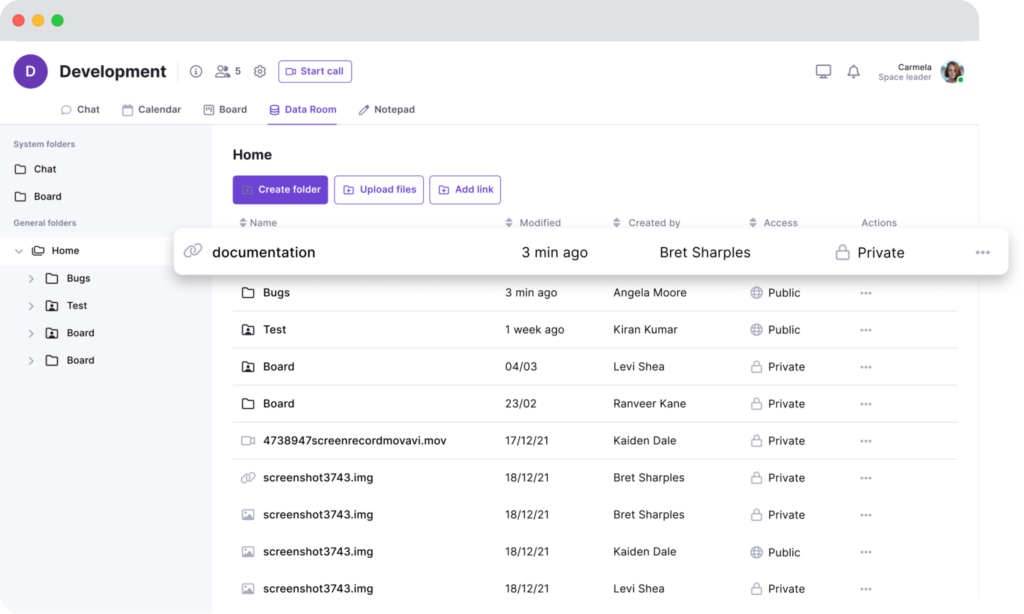
Data Management
- Data Room: Securely store, upload, and share files in various formats, including Excel, Word, PDF, and images. Set permissions per file to ensure data security.
- Wiki & Notes: Document ideas and meeting notes in the Wiki, and use Notes for personal notetaking across all spaces, only visible to you.
Dashboard
- Centralized Management: Oversee your events, tasks, data, and more from a dedicated dashboard, simplifying project oversight and management.

Why Choose Teamplate?
- All-in-One Platform: Say goodbye to juggling multiple tools and integrations. Teamplate brings everything you need into one intuitive platform.
- Simple & Intuitive: Designed for ease of use, Teamplate minimizes the need for extensive training and onboarding, allowing your team to hit the ground running.
- Affordable & Accessible: With a freemium model that includes all features, Teamplate offers an affordable solution for teams of all sizes.
Ready to transform the way your team collaborates? Sign up for Teamplate today and experience the ultimate in productivity and efficiency!
Recap: Collaboration Tools: Your Guide to Teamwork Success!
Navigating the myriad of collaboration tools for remote teams can be overwhelming, but we’re here to simplify the process. Here’s a recap of the tools we discussed to help you pinpoint the perfect solution for your team.
Tools Covered:
- Trello: The Visual Playground
- Asana: Your Project Management Command Center
- Basecamp: More Than Just Project Management
- ClickUp: Your Comprehensive Collaboration Hub
- Teamplate: The Ultimate All-in-One Tool
Collaboration Tools for Remote Teams: A Final Note
Selecting the right collaboration tool can transform your team from disorganized and unproductive to highly efficient and cohesive. With so many options available, you can find the perfect solution for any team size, budget, and specific requirements.
By understanding the features and advantages of each tool and matching them with your team’s unique needs, you can harness the true potential of collaboration and achieve outstanding results.
Effective communication, streamlined workflows, and a unified focus on common goals are essential for successful teamwork.Embark on your project journeys with confidence! Let these collaboration tools for remote teams enable your team to reach new levels of productivity and efficiency.
When managing a project that is too complex for a simple to-do list app but not intricate enough to necessitate a full-scale project management tool, a Kanban app is the ideal solution. Kanban apps have proven their versatility across various project types. Whether it’s managing a content calendar as a blog manager, overseeing a marketing team, or juggling freelance projects and clients, Kanban boards provide an effective way to stay organized. They are even useful for personal projects, like organizing a bachelorette party. The flexibility of Kanban makes it applicable to virtually any project.
While Trello is widely recognized as the gold standard of Kanban apps, many other excellent Kanban tools are available, each with unique strengths that may better suit specific workflows. After extensive testing of numerous Kanban software options, we have identified the eight best Kanban apps that stand out for their functionality and usability. Based on this thorough evaluation, here are the best Kanban apps that can enhance your project management experience.
Table of Contents
The 5 Best Kanban Apps
- KanbanFlow – For simplicity
- Kanban Tool – For built-in time-tracking and managing client projects
- Workstreams.ai – For Kanban within Slack
- Kanbanchi – For Kanban within Google Workspace
- Teamplate – All-in-one Kanban tool

What is Kanban Board Software?
If you’re new to Kanban, it’s helpful to first familiarize yourself with the Kanban method and how it differs from Scrum and Agile methodologies. For a comprehensive understanding, you can refer to these articles on the Kanban method and the distinctions between Kanban, Scrum, and Agile. However, if you just need a quick refresher, here’s a brief overview.
Kanban Boards
Think of Kanban boards as digital workspaces. They provide a visual overview of your entire project, whether you’re building a car (Kanban was originally developed by Toyota in the 1940s!), managing a content calendar, or organizing a bachelorette party.
Kanban Lists
These represent workflows within your Kanban board. At their simplest, Kanban lists might be labeled “To Do,” “Doing,” and “Done.” However, they are most effective when they mirror the actual stages of your production process. For instance, an editorial calendar Kanban board might have lists such as “With Editor,” “Scheduled,” and “Published.”
Kanban Cards
These are the tasks within your Kanban lists. In Kanban apps, cards are moved from one list to another—typically from left to right—along the production line until they are completed.
Kanban board software, with its boards, lists, and cards, offers a flexible and visual way to manage projects of all sizes and complexities, making it a popular choice for teams and individuals alike.
What Makes the Best Kanban App?
First, it’s important to distinguish between dedicated Kanban tools and general project management apps that offer Kanban as part of their feature set. If you’re already using a project management tool you like and it includes Kanban, switching to a dedicated Kanban tool might not be necessary. General project management apps tend to be too complex if you’re only looking for Kanban functionality. Through extensive research and testing, it became clear that specialized Kanban tools are best for those focused solely on Kanban.
All the apps included in this guide are purpose-built Kanban tools. For those seeking a wider array of features, check out our lists of the best free project management apps or the best Trello alternatives.
When evaluating Kanban apps, the following criteria were considered:
Affordability
The focus is on apps that are accessible to almost everyone. They either offer robust free plans or have affordable paid plans on a per-user-per-month basis.
Customization
Every team operates differently, and projects vary widely. Therefore, the apps included are highly customizable to meet diverse user needs.
Integrations
A Kanban app is only truly effective if it integrates seamlessly with the other tools you use. Integration capabilities were a key consideration.
Ease of Use
Many sophisticated Kanban apps cater heavily to software engineering and product development teams, which can make their user interfaces intimidating for others. This guide emphasizes “lightweight” Kanban apps that are user-friendly across various industries and team structures.
AI Automation
While AI in Kanban tools is still in its early stages, some apps are beginning to use machine learning to optimize Kanban workflows. This emerging feature was also considered in the evaluations.
By focusing on these criteria, the guide aims to help you find the best Kanban app that fits your specific needs and enhances your project management efficiency.
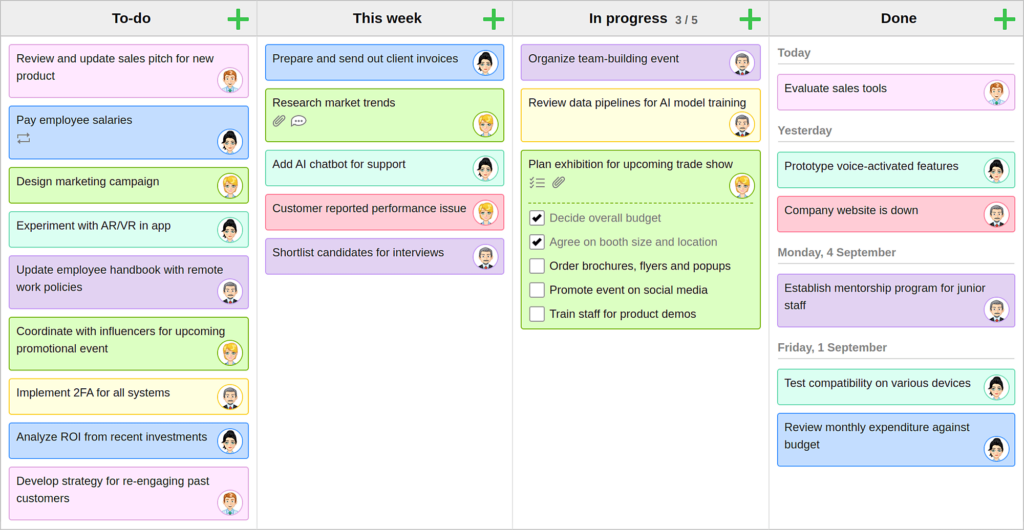
KanbanFlow: The Essential Kanban Tool
KanbanFlow stands out as the most stripped-down Kanban tool tested, but sometimes simplicity is exactly what you need. If minimal distractions are your goal, KanbanFlow is ideal.
Despite its basic nature, KanbanFlow covers all the essential features of a Kanban app and performs them well. Users can add lists and cards as usual, and customize their cards with color-coding for different task types. Additionally, swimlanes can be used to divide the board into sections, which is useful for showing multiple people’s work on one board or setting aside tasks for later.
A particularly useful feature discovered during testing is the ability to view and check off subtasks directly from the board without opening a card. When a subtask is checked off, it grays out rather than disappearing, which helps visualize overall progress towards larger tasks. Additionally, KanbanFlow allows for mass updates to cards, such as adding a new checklist of subtasks to every card in a list, which is helpful for teams working in sprints and needing to update their strategy across the board.
The card design in KanbanFlow is straightforward yet comprehensive. It allows for listing subtasks, including Markdown-formatted descriptions, adding labels, and setting time estimates for tasks. You can even create recurring cards for tasks that need to be done regularly, like in a standard to-do list app.
KanbanFlow also offers reporting on the time spent on tasks by the user and team, along with filters to sort tasks and view specific details on the boards. It’s a powerful tool for getting work done and keeping things organized without unnecessary distractions.
One of KanbanFlow’s standout features is its built-in Pomodoro timer. By clicking the timer button in the bottom toolbar, selecting a card, and starting the timer, users get 25 minutes to work on a task before being reminded to take a break. This feature supports productivity by structuring work into focused intervals.
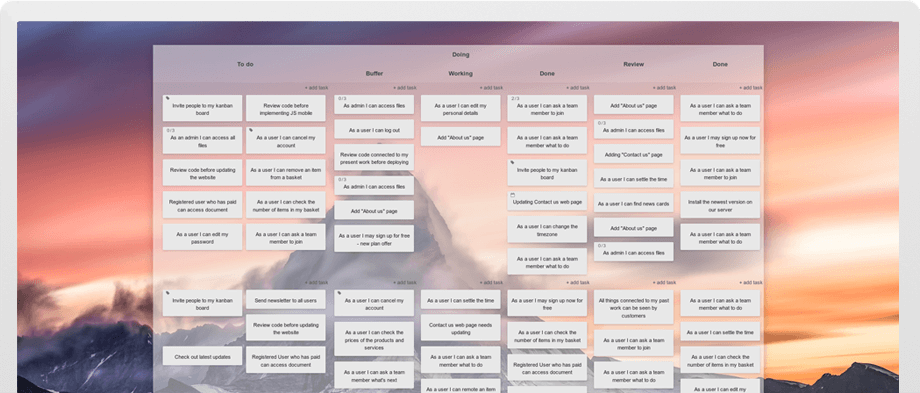
Kanban Tool: A Simple Yet Powerful Kanban App
Kanban Tool is another streamlined Kanban app featuring a clean interface with minimal distractions. While the UI hasn’t seen updates since at least 2017, its functionality remains strong. The vibrant color-coding pops off the screen, allowing users to instantly recognize task types, making standard color-labeling feel a bit insufficient in comparison.
One of the standout features of Kanban Tool is its Analytics. With a simple click from your board, you can access a breakdown of your cards by type and generate time reports to see how much work was logged each day on each card. The cumulative flow feature shows your work’s progression towards completion, and a detailed changelog records all team activities on the project. This is particularly useful for agencies or freelancers managing multiple projects for different clients simultaneously.
Despite its simple appearance, Kanban Tool boasts a host of powerful features. You can add custom fields to cards, name each card color from its settings, and enable Power-Ups for additional functionality like a calendar view, checklist templates, and emoji. All changes are logged back to the detailed analytics, providing comprehensive tracking.
Kanban Tool offers a variety of templates to help you get started, with standard columns for planning projects by time, process, and more. The board is highly customizable, allowing you to add any sections and swimlanes necessary for your workflow. Within cards, users can select a customizable color tag, add details, and quickly create and add new task cards. When working on a task, simply drag it to the sidebar on the right, and Kanban Tool will start timing your work. You can switch focus to a new task by dragging it into the sidebar.
Kanban Tool is also one of the first Kanban apps to integrate an AI assistant. The software collaborates with Open AI (the creators of ChatGPT) to enhance the setup process of your Kanban boards. The AI assistant analyzes your needs and suggests layouts and card types, and can even automatically generate project-specific content on your board. This feature significantly reduces the learning curve, allowing users to quickly adopt an effective Kanban workflow from day one.
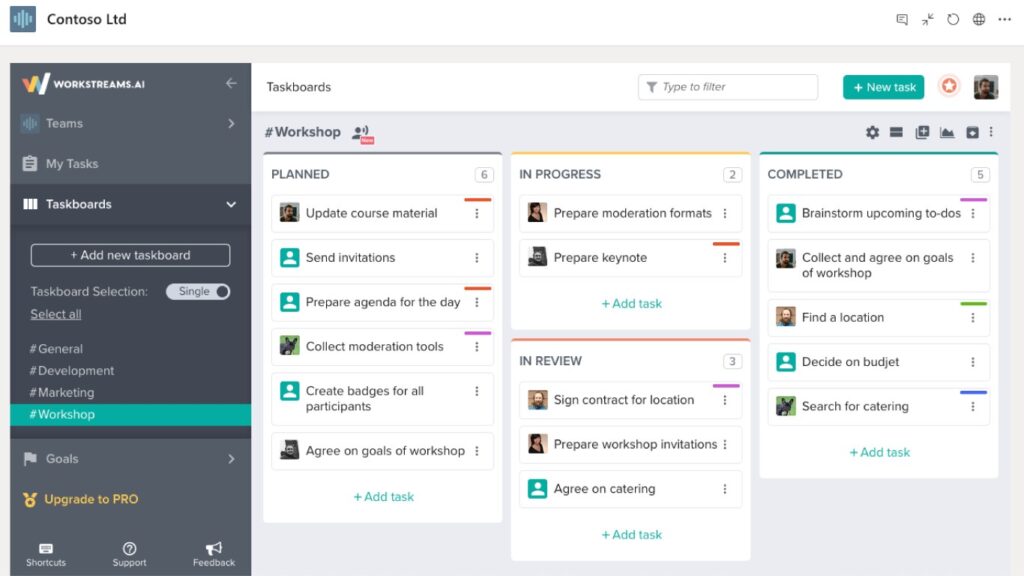
Workstreams.ai: Seamless Integration with Slack and Microsoft Teams
If you already use Slack or Microsoft Teams for team communication, Workstreams.ai is worth checking out. It offers a highly integrated Kanban experience that connects directly with your communication channels. Rather than creating a separate Workstreams.ai login, you can sign up using your Slack or Microsoft account. This tight integration allows you to manage your taskboard almost entirely from within Slack or Microsoft Teams, making project management seamless and efficient.
The taskboards in Workstreams.ai use a bot to align tasks with your Slack or Teams environment. You can create cards, check off actions, and generate reports directly from within these channels. This level of integration means you don’t have to spend much time on the Workstreams.ai interface itself.
One of the standout features of Workstreams.ai is the “Task chat” on every card, which other Kanban tools typically call “comments.” This feature ensures consistent and accessible communication around your workflows. When you tag someone in a Task chat, the notification is instant, arriving directly in Slack. This immediate notification system helps prevent important messages from getting lost, a common issue with email notifications.
The user interface of Workstreams.ai is sleek and familiar, especially for Slack users. The board design resembles Slack’s UI, making it easy to adapt to. Lists are called “Worksteps” and cards are called “Tasks,” containing all the necessary details and fields you would find in other project management apps. You can add custom fields to cards, duplicate cards with a single click, and set up recurring tasks. This comprehensive functionality is all integrated into your team chat app.
Workstreams.ai also offers various customization options. You can add custom fields to cards, duplicate a card with just one click, and set up recurring tasks. The ability to manage these directly within your team chat app enhances efficiency and keeps your workflow streamlined.
Workstreams.ai pricing includes a free plan that offers unlimited tasks and users with all core features. For additional functionalities such as Workstep automation, calendar view, and due dates, the Pro plan is available at $9.99/month/user.
By integrating deeply with Slack and Microsoft Teams, Workstreams.ai provides a robust and user-friendly Kanban experience, ensuring smooth project management without the need to switch between multiple platforms.

Kanbanchi: Perfect for Google Workspace Users
Kanbanchi isn’t a Google product, but it has been specifically designed to work seamlessly with Google Workspace. This Kanban app integrates tightly with Google Calendar, Google Meet, Google Drive, Gmail, and other Google apps. Despite its Google-centric functionality, the interface design closely resembles that of a Microsoft product, making it look like it could be a feature within Microsoft Teams. However, its features and integrations are clearly aimed at Google loyalists.
For example, you can click an “Add to Google Calendar” button on any card to copy task due dates to your Google Calendar, ensuring you get notifications from there. It’s also easy to attach files to cards straight from Google Drive, and conversely, you can add your Kanban board to your Drive. Additionally, you can create cards for your Kanban board directly through Gmail by emailing a specific address.
One of the features that stood out in Kanbanchi is the built-in time tracker, which begins tracking your time when you click “Start working on it.” You can also add custom properties to all cards on a board in bulk with one action. If you’re already using Trello or Jira for Kanban and considering switching, you can import entire boards directly from these apps or from a CSV, and they’ll appear in full on Kanbanchi.
However, Kanbanchi does not come with a free plan, and its pricing has increased recently. The Premium plan is $16.99/month/user, and if you need time-tracking and reporting, the Professional plan is $41.99/month/user. If you’re a Google Workspace user who spends most of your time in Gmail, it might be worth checking out a Kanban for Gmail app like Sortd if budget is a concern. Alternatively, you can create your own Kanban board in Google Sheets.

Teamplate: The Ultimate Kanban App with All-in-One Collaboration Tools
Teamplate is a user-friendly, all-in-one collaboration tool designed to meet the diverse communication and project management needs of smaller scale companies. Built to rival tools like Slack, Zoom, Jira, and Confluence, Teamplate combines their functionalities into one cohesive platform, eliminating the need for context switching and allowing users to focus on productivity.
Kanban Boards: The Core of Teamplate
Organize Workflows
- Customizable Boards: Tailor your Kanban boards to fit your unique project needs. Whether you’re managing a product launch, a marketing campaign, or daily team tasks, you can set up boards that reflect your specific processes.
- Epics and Sprints: Break down large projects into manageable chunks with epics and sprints. This feature helps in planning and tracking long-term projects by dividing them into smaller, actionable tasks.
- Task Categories: Use color-coded categories to differentiate between various types of tasks. This visual distinction makes it easy to prioritize and manage different work streams.
Views
- Backlog View: Keep a comprehensive list of all tasks that need to be addressed. This view helps in planning and prioritizing future work without cluttering your active board.
- Kanban View: The traditional Kanban view allows you to see tasks in their respective stages of completion. Move tasks from ‘To Do’ to ‘In Progress’ to ‘Done’ with simple drag-and-drop functionality.
- Board View: For a more detailed overview, switch to the board view. This view offers additional insights into task details, deadlines, and assigned team members, helping you stay on top of every aspect of your project.
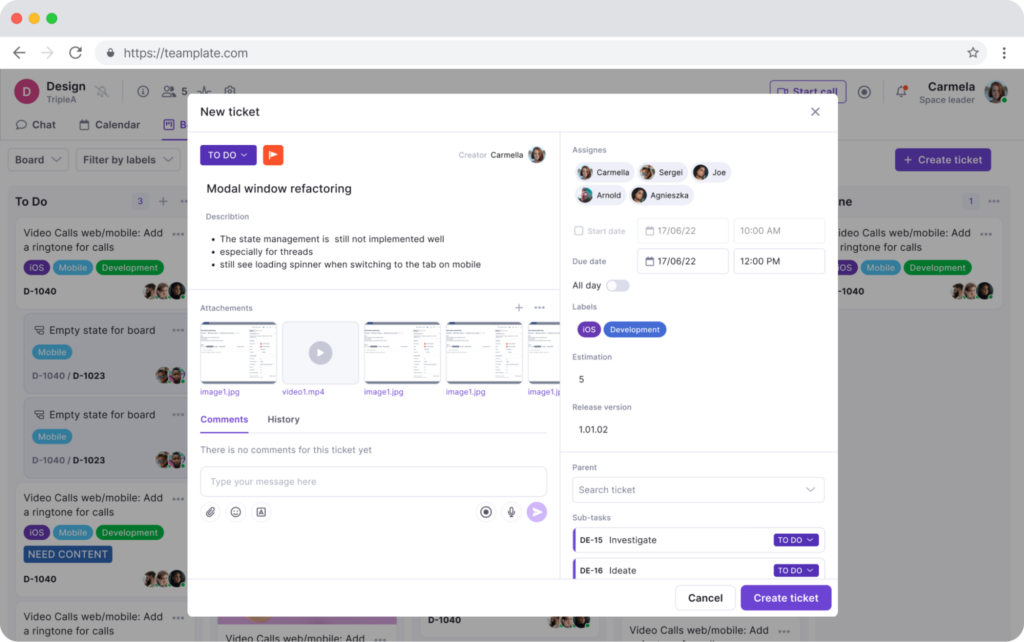
Task Management
- Drag-and-Drop Interface: Easily move tasks through different stages of your workflow with an intuitive drag-and-drop interface. This simple interaction streamlines task updates and ensures everyone is aware of the current status.
- Task Details: Click on any task to view and edit its details. Add descriptions, attach files, set due dates, and assign team members to ensure all relevant information is readily available.
- Subtasks and Checklists: Break down tasks into smaller, manageable subtasks. Use checklists to track progress within a task, ensuring nothing falls through the cracks.
- Labels and Tags: Organize tasks with labels and tags for quick identification and filtering. This feature is especially useful for categorizing tasks by priority, department, or project phase.
- Notifications and Alerts: Stay informed with real-time notifications and alerts. Teamplate keeps you updated on task changes, upcoming deadlines, and team activities, ensuring you never miss an important update.
Collaboration Tools
- Comments and Mentions: Facilitate team collaboration with task-specific comments. Mention team members to draw their attention to specific tasks or updates, promoting clear and efficient communication.
- Attachments: Attach relevant documents, images, and files directly to tasks. This centralized storage ensures all necessary materials are easily accessible and organized.
- Activity Logs: Track the history of each task with activity logs. See who made changes, when they were made, and what was updated, providing transparency and accountability within the team.
By integrating these robust features, Teamplate’s Kanban boards offer a powerful, flexible, and user-friendly way to manage your projects. They ensure that you can visualize progress, manage tasks effectively, and keep your team aligned and productive.

Why Choose Teamplate?
- All-in-One Platform: Eliminate the need for multiple tools and integrations by using Teamplate for all your collaboration and project management needs.
- Simple & Intuitive: The easy-to-use interface minimizes training and onboarding time, allowing teams to start collaborating immediately.
- Affordable & Accessible: Teamplate’s freemium model offers all features, making it an accessible solution for teams of all sizes.
By choosing one of these top Kanban apps, you can significantly enhance your project management efficiency and ensure your team stays organized and productive.
Conclusion
Choosing the right Kanban app can significantly impact your project’s success and your team’s productivity. The five Kanban apps highlighted in this guide each offer unique strengths that cater to different needs and workflows.
- KanbanFlow provides a straightforward, distraction-free interface, perfect for those who value simplicity.
- Kanban Tool offers robust features and detailed analytics, making it ideal for agencies and freelancers managing multiple projects.
- Workstreams.ai excels in seamless integration with Slack and Microsoft Teams, bringing Kanban functionality directly to your communication channels.
- Kanbanchi is a top choice for Google Workspace users, with strong integration capabilities and a familiar interface.
- Teamplate stands out as the ultimate all-in-one collaboration tool, combining the best aspects of Kanban boards with a comprehensive suite of communication and project management features.
Among these, Teamplate emerges as the best Kanban app, thanks to its user-friendly design, extensive customization options, and powerful collaboration tools. Whether you’re managing a product launch, coordinating a marketing campaign, or organizing daily team tasks, Teamplate’s all-in-one platform ensures that you can streamline your workflows, enhance productivity, and keep your team aligned and focused.
By integrating the right Kanban app into your workflow, you can transform your project management experience, making it more efficient, organized, and effective. Explore these options and find the one that best fits your needs to elevate your project management game.
Project management and team collaboration thrive on clarity and openness. It’s essential that everyone involved is fully informed and in sync .
A key strategy to achieve this is implementing the Kanban framework, renowned for enhancing transparency and streamlining work processes.
This article will introduce you to the Kanban board, a vital tool in this methodology. We will also showcase over 10 outstanding Kanban board examples, providing valuable insights and ideas for your project management endeavors.
Ready to dive in?
Let’s begin.
Table of Contents

What is a Kanban Board?
A Kanban board visually maps out your workflow using columns that denote different stages of a task’s progress. This board is a cornerstone of the Kanban method, an agile approach emphasizing team communication, ongoing enhancement, and openness.
On a Kanban board, tasks are categorized into defined queues such as “To-Do,” “In Progress,” and “Done,” mirroring the specific requirements of your workflow process.
What are the Benefits of a Kanban Board in Project Management?
A Kanban board exemplifies a fundamental yet highly effective method for tracking and managing workflows and tasks. By utilizing various color-coded cards arranged in distinct lanes, this basic Kanban board structure provides a clear and comprehensive view of ongoing projects and their current status.
The primary objective of a Kanban system is to manage and optimize workflow. By setting limits on work in progress, it ensures that team members focus on completing current tasks before embarking on new ones. This approach is crucial in preventing overload and promoting a smooth progression through the workflow.
Continuous refinement and enhancement are at the heart of Kanban, especially relevant for teams in fields like software development and marketing. With each iteration, or ‘sprint,’ teams can assess the pace of task progression, the time taken to initiate tasks, and the frequency of tasks returned for revisions or due to bugs. This ongoing evaluation, a key element of the Lean methodology and encapsulated in the Kaizen system, enables teams – whether in software development, marketing, sales, or other domains – to identify and eliminate inefficiencies, leading to better resource utilization and time management.
The versatility of Kanban boards, including online Kanban board options, allows for adaptation to a variety of team needs, from software development teams to marketing and sales Kanban boards, making them a valuable tool across various sectors.

10+ Project Management Kanban Board Examples
Get your game face on cause we’re about to play our ace by showing you some fantastic Kanban examples.
And if you’re already familiar with the rules of the game, you can start creating an online Kanban board right away – just explore teamplate Kanban board.
1. Project Management
Embarking on project management with a Kanban board isn’t just about organization – it’s about transforming abstract plans into tangible results. The first step is designing a straightforward yet comprehensive board with columns that include:
- Business Requirements
- Ready to Start
- In Progress
- Delegated to Clients
- Done
Incorporating tasks from every department onto your cards, you create a dynamic project management dashboard. This setup not only tracks what each team member is doing at any moment but also offers a panoramic view of the entire project’s progress.
On paper, this structure seems perfect. However, the true challenge lies in bringing this Kanban board to life. Relying on a physical, paper-based system might seem tempting, but in the fast-paced world of project management, this approach is as fragile as a house of cards.
To avoid the pitfalls of outdated methods, it’s essential to leverage the most efficient Kanban tools available. Take Teamplate’s Board, for example, which elevates your Kanban experience with features like:
- Effortless drag-and-drop for moving cards
- Sorting tasks by various criteria such as Status, Assignees, Priority, Tags, and Due Dates
- A comprehensive view of tasks throughout your entire Workspace
- The option to add visually appealing cover images to your cards

2. Product Management
The dynamic world of product development in industries such as SaaS, manufacturing, and software development demands versatile and adaptive management tools. Moving away from the conventional Scrum boards, these sectors are increasingly embracing the flexibility offered by Kanban boards.
Let’s delve into how different product development sectors can tailor Kanban boards to suit their unique processes:
Software Development
Stages on the Kanban board might include
- Design
- Development
- Code Review
- Testing/Quality Assurance
- Deployment
Lean Manufacturing
Here, the Kanban stages could be
- Ordered
- Scheduled
- Manufacturing
- Inspection
- Shipping
- Delivered
SaaS Development
The workflow can be simplified into stages like
- Backlog
- Work in Progress
- In Review
- Done
Kanban boards in product management serve as invaluable tools for tracking and managing critical aspects of product development. They offer real-time visibility, which is especially useful for stakeholders. For instance, when a stakeholder inquires about the status of a product, the software development team can immediately refer to the Kanban board and provide a prompt update. This level of immediacy and transparency is not just convenient; it’s crucial in today’s fast-paced business environments.

3. Real Estate
In the dynamic realm of real estate, a well-structured Kanban board can be a powerful tool for sales agents, enhancing their ability to effectively manage leads, negotiations, and oversee their entire sales funnel. Implementing a Kanban board into your real estate CRM system can revolutionize the way sales processes are handled, offering clarity and efficiency at every step.
Consider incorporating these meticulously designed stages into your sales Kanban board:
- Contacted – marking the initial interaction with potential clients.
- Interested – identifying prospects who have shown interest in the listings.
- Negotiating – the phase where terms and conditions are being discussed.
- Contract Sent – indicating that the official paperwork has been forwarded to the client.
- Contract Received – acknowledging the receipt of the contract by the client.
- Signed – the stage where the client signs the contract, signaling a commitment.
- Deal Closed – the successful conclusion of the sales process.
By integrating these stages into the sales process within your real estate CRM, your team gains unparalleled visibility into the journey of each prospective customer. This structured approach ensures that every lead is meticulously tracked and managed, minimizing the chances of missed opportunities or lapses in communication. Furthermore, this systematic method empowers your agents with the insight to determine the most opportune moments for client engagement. It goes beyond mere transactional interactions and builds towards nurturing a relationship with the client, ensuring contact is made when it is most effective and welcome, rather than at inconvenient times.

4. Construction
Kanban boards serve as a versatile and effective tool for managing and scheduling construction projects of all scales, from small to large-scale organizations. By adopting the Kanban method, construction teams can enhance their project management strategies and streamline their workflows.
Consider, for instance, the construction project lifecycle. This typically encompasses phases like
- Planning
- Initiation
- Bidding and Procurement
- Construction
- Close-out.
By utilizing a Kanban board, each of these phases can be subdivided into more granular, manageable tasks.
Taking the Construction phase as an example, it can be further broken down into specific tasks such as
- Demolition
- Framing Structure
- Pouring Concrete.
These detailed subdivisions on the Kanban board not only make the project more manageable but also provide clear visibility into each stage of the process.
In the context of marketing, a marketing Kanban board can be similarly structured to manage various aspects of a content marketing campaign. For operations teams, an operations Kanban board can streamline processes, from daily logistics to long-term strategic planning. Portfolio Kanban boards can be employed for high-level project overviews, making them an invaluable tool for senior management to oversee multiple projects simultaneously. The real power of Kanban boards lies in their adaptability. Whether you’re creating your own Kanban board from a template or using pre-designed board examples, they can be tailored to suit the specific needs of a project or team. This is particularly beneficial in agile environments, such as agile construction teams or agile marketing teams, where flexibility and responsiveness to change are crucial.

5. Student
For students juggling multiple projects and assignments, adopting an agile Kanban board can be a game-changer. It’s a practical way to organize projects, collaborate on group tasks, and keep tabs on schedules and assignments. With tools like Excel or Google Sheets, creating a personalized Kanban board template is both accessible and effective.
Consider adding these columns to your student Kanban board to efficiently track project progress:
- To-Do: List all pending tasks.
- Subject: Categorize tasks by academic subjects or project titles.
- Assigned Type: Distinguish between individual and group tasks.
- In Progress: Track ongoing tasks.
- Done: Monitor completed assignments.
When facing a substantial project, breaking it down into smaller, more manageable tasks is key. Take, for example, the assignment of reading William Shakespeare’s “Hamlet.” Instead of overwhelming yourself with the task of reading the entire play at once, divide it into segments:
- Read Acts 1 & 2
- Read Act 3
- Read Acts 4 & 5
This approach not only simplifies the task but also provides a clear path to completion.
Group projects can especially benefit from this method. Utilizing a feature like ClickUp’s Multiple Assignees, team members can divide the project into smaller tasks and assign them accordingly. This facilitates clear communication and coordination within the group, allowing each member to track progress and contribute effectively. As a result, the team can ensure that the project is progressing smoothly and is on track for timely submission.
6. Marketing
In the bustling world of content marketing, managing a myriad of tasks ranging from project deadlines to client feedback and campaign advancement is crucial. Without an effective system to track these diverse activities, it’s challenging for marketing teams to gauge their progress and efficiency.
This is where a content marketing Kanban board becomes an essential tool. It enables teams to monitor various activities seamlessly, from website design management to SEO optimization. A well-structured Kanban board for marketing teams might include stages such as:
- Backlog – a reservoir of planned tasks and ideas.
- To-do – tasks that are queued for execution.
- In Progress – current, actively worked-on tasks.
- Pending Approval – tasks awaiting confirmation or feedback.
- Rejected – tasks that require reevaluation or modification.
- Final – completed tasks that have met all requirements.
To enhance this system further, consider integrating an “In Campaign” column. This addition provides real-time insight into active promotions, allowing for prompt adjustments and optimizations.
Moreover, the application of Kanban swimlanes can elevate the organization and clarity of the board. These swim lanes allow for a visual segregation of distinct marketing activities. For instance, one swim lane might be dedicated to “Marketing Metrics,” focusing on analytics and performance tracking, while another could be for “Weekly Newsletter,” streamlining the newsletter creation and distribution process.
7. Weekly Planning
Navigating through the maze of ambitious weekly goals only to find ourselves falling short is a scenario many of us know all too well. The irony is not lost that seven days often leave us feeling, well, weak.
Enter the weekly planning Kanban board, a tool adept at transforming the often chaotic process of agile sprint planning, habit building, and task management into an organized, manageable system. Here’s a streamlined approach to setting up your weekly task board, a tool equally valuable for content marketers, project managers, and team members alike:
- Weekly Goal Setting – at the start of each week, identify and select a handful of achievable tasks from your content marketing Kanban board. This focused approach ensures that you’re not overcommitting.
- Single-Task Focus – adopt a strategy of working on one task card at a time. This method fosters deeper concentration and more efficient task completion.
- Break It Down – for every project task on your card, add subtasks. This breakdown converts overwhelming tasks into smaller, more achievable steps, aligning well with team member specialties and allowing for easier tracking and task management.
- Future Planning with Swimlanes – implement swimlanes on the same board for subsequent weeks, such as weeks two, three, etc. This setup allows for continuous improvement in your planning and provides a clear visual path for forthcoming tasks.
This weekly planning Kanban board not only aids in effective task management but also serves as a guide for project managers and teams to align their efforts with the set objectives. The clarity and structure it brings to the often hectic workweek are invaluable for maintaining focus and driving toward success.

8. Creative and Media Development
When managing complex workflows that involve creative processes, project managers and support teams often face priority conflicts. These challenges are especially pertinent when working across multiple teams and balancing numerous tasks. A practical solution to these challenges is the implementation of several Kanban boards, each tailored to distinct facets of media management.
Let’s explore how Kanban boards can be structured to streamline operations in different areas of media and content management:
Content Creation Planning Kanban Board
This board can track the progression of content from its inception to promotion with stages like
- Requested
- In Progress
- Copy Approval
- Design
- Implementation
- Promotion.
- Such a setup assists project managers in overseeing the entire content creation lifecycle.
Photoshoot Kanban Board
A dedicated board for photoshoot projects could include stages such as
- Concept
- Planning
- Scheduled
- In Progress
- Editing
- Edited
- Delivered
This allows teams to manage each phase of the photoshoot effectively, reducing the risk of priority conflicts.
Content and Social Calendar Kanban Boards
For managing content across various digital platforms, boards could be organized into stages like
- Ideas
- Scheduled This Week
- Scheduled Next Week
- Later This Month
- Published
This structure is particularly beneficial for support teams coordinating content publication across multiple platforms and timelines. These Kanban boards serve not only as tools for tracking the progress of individual tasks but also as platforms for collaborative effort among multiple teams. By clearly defining stages and tasks, they help in prioritizing and resolving conflicts, ensuring that each team member knows their responsibilities and deadlines. The visual nature of Kanban boards facilitates easier communication and a unified approach to project management, essential in the dynamic environment of creative media.
9. Personal Project Management
Kanban boards are not just powerful tools for managing successful projects within a professional context; they can also be incredibly useful for organizing personal projects, from vacation planning to home renovations. While diverse team members in a workplace might use separate boards for various tasks such as the hiring process or product development process, individuals can similarly utilize Kanban boards for their personal planning.
Let’s take vacation planning as an example, even in times when travel may be restricted, like during COVID lockdowns. A personal Kanban board can be a hopeful tool for mapping out future holiday plans. Instead of the typical project-focused columns like to-do, in progress, and done, you can customize your board to fit the nuances of travel planning. Columns might include:
- Admin – for managing bookings, travel insurance, and other administrative tasks.
- Packing – checklist of items to pack for the trip.
- Tourist Attractions – planning and scheduling visits to various sites and attractions.
- Food and Drinks – researching and noting down must-try local cuisine and dining spots.
Incorporating visual elements, such as images of beaches or destinations, into your vacation Kanban board can also add an element of excitement and motivation, especially when physical travel is limited. These images serve as a reminder of the enjoyable experiences that await and can be a delightful contrast to the mundane backgrounds we’ve grown accustomed to in virtual meetings.

10. Event Management
Kanban boards are remarkably versatile and can be a tremendous asset in planning and executing a variety of events, from enchanting weddings to dynamic work functions. Their visual nature and customizable framework make them an ideal tool for event project management.
When creating a Kanban board for event planning, the standard columns – such as To-Do, In Progress, and Done – provide a solid foundation. However, the true magic of Kanban in event planning lies in its ability to be tailored to the specific nuances of event management.
- Custom Columns for Specific Needs – apart from the standard columns, you can add specific ones like “Design Ideas”, “Vendor Contracts”, “RSVPs”, or “Day-of-Event”. These specialized columns allow for tracking different aspects of event planning in an organized manner.
- Visual Inspiration and Confirmation – adding images to your Kanban board can greatly enhance the planning experience. For instance, if you’re organizing a wedding, you can upload pictures of potential flower arrangements, cake designs, and decor themes directly onto the board. This not only serves as a visual reference but also helps in sharing ideas with others involved in the planning process.
- Pending Approval Column – a “Pending Approval” column is particularly useful for tracking items that require confirmation or approval. This can include contracts waiting to be signed, invoices needing clearance, or decisions on venue bookings. Having this column ensures that you’re always aware of what’s awaiting action, preventing bottlenecks in the planning process.
- Collaboration and Updates – for events that involve multiple organizers or stakeholders, a Kanban board can be an effective platform for collaboration. Team members can update the board with new information, track progress, and see at a glance what others are working on. This facilitates clear communication and keeps everyone on the same page.
- Flexibility and Adaptability – as event details can often change, the flexibility of a Kanban board to adapt quickly is invaluable. You can easily move tasks between columns, update details, and rearrange priorities as the planning evolves.
Whether it’s for a family gathering, a corporate event, or a celebratory occasion like a wedding, a Kanban board not only helps in organizing the myriad details involved but also makes the process more engaging and less overwhelming. It transforms the daunting task of event management into a more structured and enjoyable journey.
11. Human Resources
Investing in high-quality Kanban software apps can significantly transform the operations of an HR department, steering it away from the frantic pace often associated with fire-fighting to a more organized, efficient state. Here’s why incorporating a Kanban board into HR practices can be a game-changer:
- Streamlined Recruitment Process – an HR Kanban board can revolutionize the hiring process. Recruiters can visually map out each stage of recruitment, from initial application screenings to final interviews and offers. This clarity allows for tracking the progress of each candidate effectively, ensuring no one slips through the cracks.
- Enhanced Candidate Retention – by organizing and prioritizing tasks on the Kanban board, recruiters can respond more promptly to candidates, keeping them engaged and interested. This timely communication is key in retaining top talent, especially in competitive job markets.
- Maintaining Recruiter Sanity – the organized nature of a Kanban board can significantly reduce the stress and chaos that often accompany recruitment. By having a clear overview of all ongoing processes, recruiters can manage their workload more effectively, leading to a less frenetic, more controlled work environment.
- Improving Candidate Experience – the efficiency brought about by the Kanban system directly impacts the candidate experience. Faster response times, transparent communication, and a streamlined process make for a more positive interaction with potential employees. A smooth and professional recruitment process reflects well on the company’s brand and increases the likelihood of candidates accepting offers.
- Collaboration and Visibility – kanban boards foster better collaboration among team members. Everyone in the HR team, from recruiters to hiring managers, can view the progress of various tasks and understand their roles and responsibilities in the recruitment process. This shared visibility promotes a cohesive team effort and reduces the chances of miscommunication.
- Continuous Improvement – with the Kanban methodology, there’s always room for refinement. HR teams can regularly review and adjust their processes, responding to changes in the recruitment landscape or internal company policies. This adaptability is crucial for maintaining an efficient and effective hiring process.

Conclusion
The adoption of a Kanban board in various departments, particularly in HR, can lead to transformative changes in efficiency, communication, and overall workflow management. The benefits of utilizing such a system are extensive: from streamlining recruitment processes to enhancing candidate experience, and from maintaining team sanity to fostering continuous improvement.
For organizations looking to implement this system, Teamplate offers a robust Kanban board solution that is worth exploring. Their platform is designed to cater to the diverse needs of different teams and projects, making it an ideal choice for those seeking to enhance their productivity and organizational capabilities. By integrating Teamplate’s Kanban board into your workflow, you open up opportunities for greater collaboration, transparency, and efficiency. It’s a step towards not just organizing tasks but optimizing entire processes, ensuring that your teams are working at their best and delivering exceptional results.

Maintaining efficiency and organization in the fast-paced corporate environment of today is not only advantageous, but also essential to success.
This is where business management software comes into play, giving contemporary companies the tools they need to improve efficiency and streamline processes. But the obstacle for a lot of startups and small enterprises is usually the high price of purchasing all-inclusive software solutions.
These costs may pose a serious obstacle, making it more difficult for them to successfully compete with bigger companies.
In this piece, we explore the world of free all-in-one business management software and how these tools can help small businesses run more efficiently than their more affluent competitors.
They also offer a cost-effective solution for these businesses. Knowing the possibilities of these software programs may be the key to increasing productivity and propelling your company ahead, regardless of size.
Table of Contents
The idea of free all-in-one business management software has surfaced as a revolutionary answer to this problem. Various tools for optimizing different parts of a business are included in this program, which is seamlessly integrated into one platform.
In the midst of the daily flurry of business activity, it helps teams keep on top of their work and guarantees that nothing is missed. Business management software is essential for streamlining internal operations and building a customer knowledge base.
It does this by facilitating tasks, project collaboration, time monitoring, and process documentation.
However, what precisely is software for company management? Fundamentally, it is a collection of software, hardware, and applications that let an organization control, automate, and enhance its operations.
Comprehensive features like customer relationship management, cloud storage and data management, enterprise project management, business metrics tracking, invoicing and budgeting, analytics and reporting, and workflow automation are all part of what makes the best business management software, which goes beyond the essentials.
10 Top All-in-One Business Management Softwares
What constitutes the finest company management software varies from person to person.
To assist you in selecting the best company management platform for your requirements, we’ve listed the most widely used ones.
Now let’s get going!
Teamplate
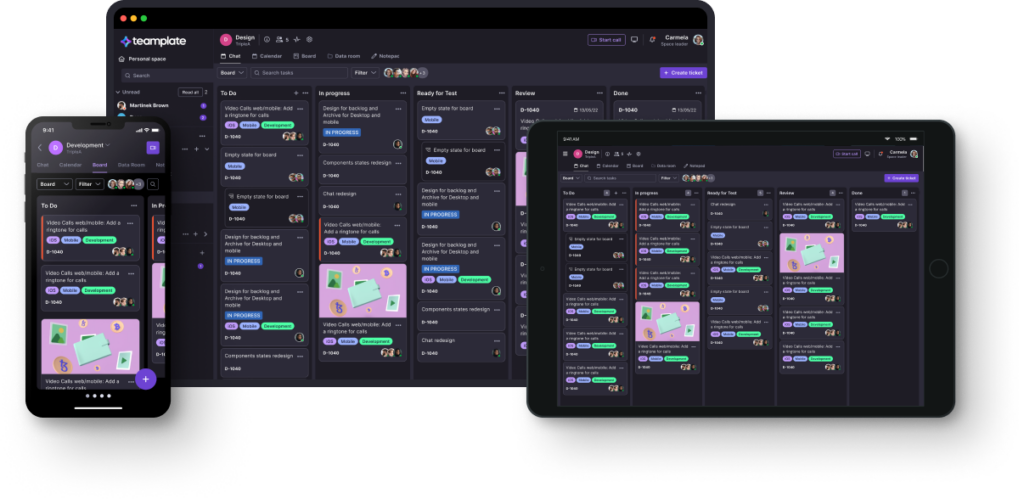
Teamplate sets itself apart as a flexible project management solution praised for its wide range of advanced capabilities. These carefully designed features make it easier to handle tasks, allowing for the effective administration of different project components like as sprints, epics, and checklists. This novel method raises the bar for organization and execution and completely changes the way teams approach project management. Fundamentally, Teamplate provides a wide range of functionalities that enhance project management with both precision and efficiency. This powerful system can easily accommodate teams of various sizes, enabling them to work on projects with remarkable precision and agility. Beyond the fundamentals of project management, Teamplate provides a unified platform that changes with the needs of teamwork and project advancement.

Key Features:
- With Teamplate, teams can easily create and manage epics, which gives them a clear picture of how their project is progressing and helps them to fully comprehend their objectives.
- Teamplate’s sprint feature highlights how important timing is to project management, enabling teams to break up their work into smaller, more manageable chunks and focus on particular tasks for predetermined amounts of time. This strategy helps to monitor project progress in addition to increasing efficiency.
- By incorporating agile approaches, Teamplate goes beyond basic tools and empowers teams to flourish in hectic project environments.
- Teamplate’s user-friendly design puts job management ahead of feature complexity, making it an excellent option for businesses of all sizes.
- The checklist feature of Teamplate takes a meticulous approach to work division, guaranteeing close monitoring and control.

Advantages of Teamplate:
- The harmonious combination of sprints, epics, and checklists offers unparalleled project management flexibility while reducing project execution uncertainty.
- Teamplate’s per-user price approach is flexible enough to accommodate small teams as well as large organizations, and it meets a wide range of business needs.
- Adopting agile methodologies ensures prompt adaptation to changing project circumstances.
- Simple interfaces are easier to use and encourage quick adoption.
- Uses technologies made especially for efficient communication and group decision-making to encourage cooperation.
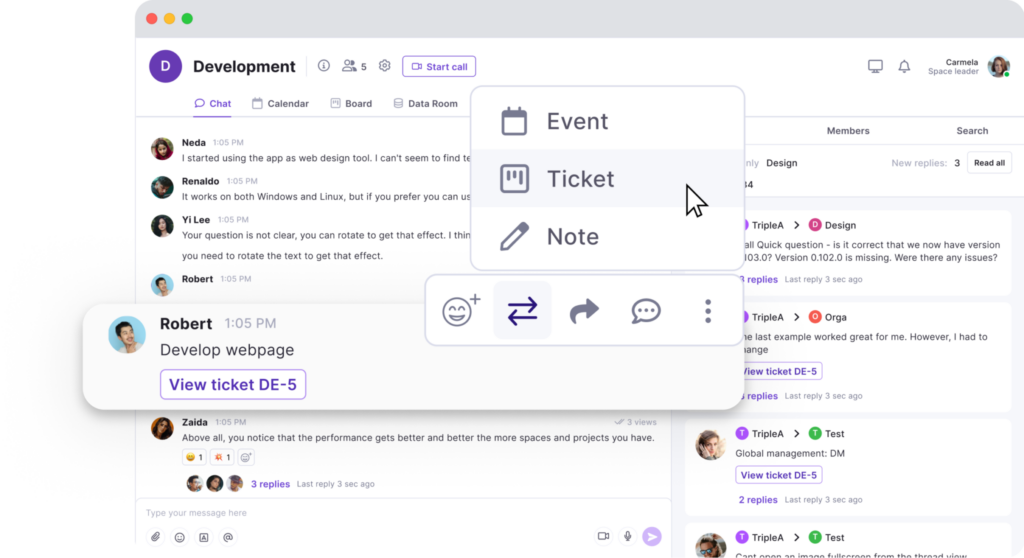
Pricing:
- Available as a ‘Free Forever’ plan.
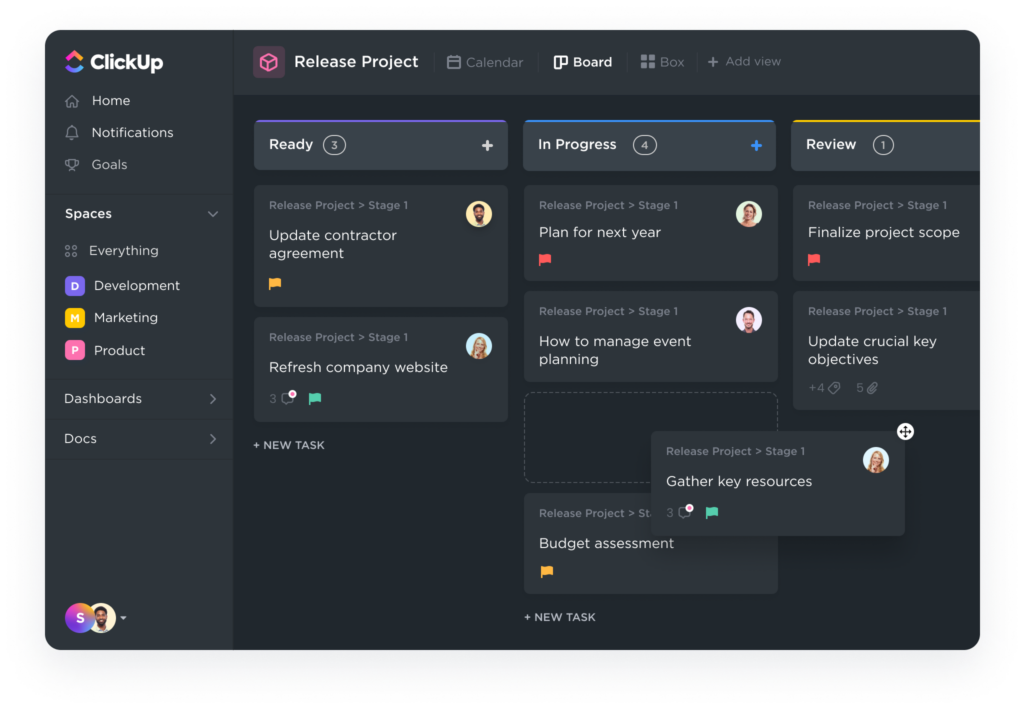
Clickup
In the dynamic realm of modern business, the right tools can make all the difference. Business management software has become an indispensable asset for companies aiming to streamline their operations and enhance productivity. Among these tools, ClickUp emerges as a versatile and powerful project management tool, ideal for a range of business environments. This enterprise business management software offers adaptability and robust features, making it suitable for varied teams—from software companies with multifunctional groups to agencies collaborating with clients.
ClickUp is more than just free CRM software; it’s a comprehensive project management solution designed to boost speed and efficiency across teams. Its array of potent features is tailored to improve time management and workload distribution, making it an invaluable asset in the toolkit of any efficient business.
Advantages of ClickUp:
- Highly Adaptable Dashboards – the software’s dashboards allow team members to easily visualize and organize their daily tasks, enhancing resource management and task prioritization.
- With ClickUp, setting and tracking organizational objectives and milestones is streamlined, thanks to its functionality for organizing OKRs (Objectives and Key Results) coupled with real-time progress reporting.
- A vast selection of pre-designed templates is available, catering to a variety of tasks and needs. These templates can be personalized to fit specific project requirements and to automate workflows effectively.
Limitations of ClickUp:
- New users may find there’s a learning curve to fully exploit all the advanced functionalities that ClickUp offers.
- The free version of this free business management software is limited to 100MB of storage, a limitation that can be removed with an affordable upgrade.
Pricing:
- Free Forever Plan: Offers basic functionalities for individuals or small teams.
- Unlimited Plan: Priced at $5/month per user, suitable for small to medium-sized teams.
- Business Plan: At $12/month per user, this plan is ideal for larger teams needing advanced features.
- Business Plus Plan: Priced at $19/month per user, offering additional functionalities for complex needs.
- Enterprise Plan: Custom pricing is available for this plan, designed for large organizations with extensive requirements.

Trello
In your quest for efficient business management tools, you might have stumbled upon Trello, renowned for its effectiveness in project and task management. Trello has gained popularity for its user-friendly interface and straightforward approach, making it less intimidating than many other project management software options. It’s particularly noted for its capacity in task management and its utility in streamlining business operations.
Advantages of Trello:
- Trello provides a platform for automating various business processes with its extensive community and template library.
- The software allows for numerous integrations, enhancing its functionality and adaptability to different business needs.
- Stay productive on the go with Trello’s mobile applications, designed for ease of use and efficiency.
- Trello’s pricing structure is reasonable, offering good value for the features it provides.
Limitations of Trello:
- Trello may not be as flexible for larger teams looking for more complex task management solutions.
- The reporting functionalities are somewhat basic, which might be a drawback for businesses needing in-depth analytics.
- The free version comes with limited storage, which could be a constraint for businesses with larger data requirements.
Pricing:
- Free Forever: This tier offers unlimited cards, up to 10 boards per team, 10MB file size per upload, custom backgrounds, mobile app access, and 250 workspace command runs.
- Standard: Priced at $5/user/month, it includes unlimited boards, 250MB per file upload, saved searches, custom fields, advanced checklists, and single-board guest access.
- Premium: At $10/user/month, it adds multiple views (dashboard, timeline, map view, and table views), priority support, and simple data exports.
- Enterprise: For $17.50/user/month, it provides organization-wide permissions, public board management, and multi-board guest access.
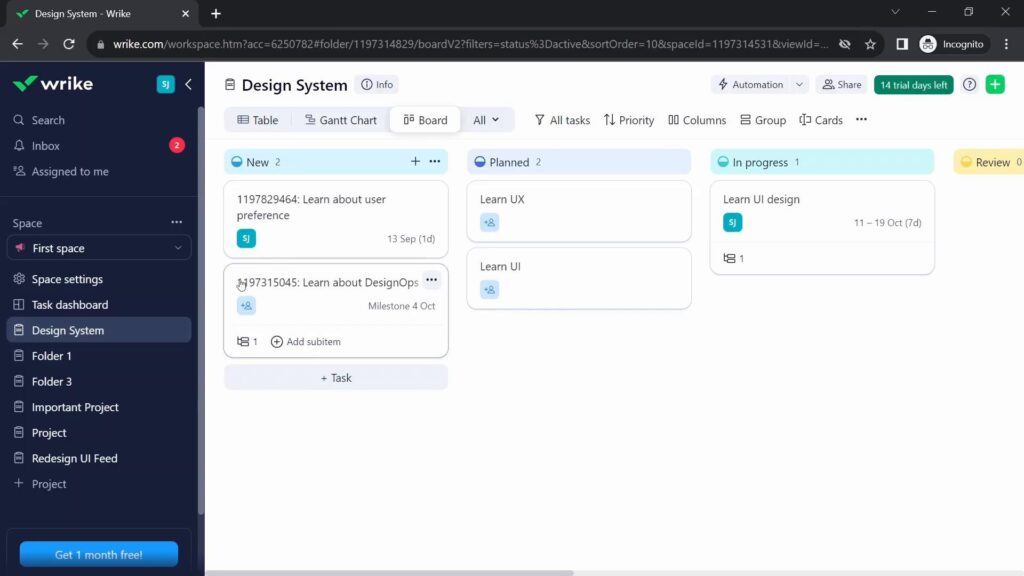
Wrike
In the realm of business software, especially for those seeking solutions in business process automation and task management, Wrike emerges as a notable contender. This cloud-based management software is tailored to enhance team workflows and foster better collaboration. It stands out as a versatile platform, combining the functionalities of a free office suite with robust project management tools.
Advantages of Wrike:
- Wrike excels in offering detailed task management capabilities, enabling businesses to create, assign, and monitor tasks across various projects and teams efficiently.
- With over 400 integrations, Wrike can seamlessly blend into any business’s existing software ecosystem.
- It provides in-depth reporting features, offering valuable insights into project performance and progress.
Limitations of Wrike:
- The feature-rich interface of Wrike might be overwhelming for new users, particularly those unfamiliar with complex management software.
- Some users might find the customization options in Wrike to be somewhat restricted.
Pricing:
- Free Tier: Wrike offers a free software version, making it a great entry point for small businesses or teams new to business software.
- Team Plan: Priced at $9.80/month per user, this plan is designed for smaller teams seeking more functionality.
- Business Plan: At $24.80/month per user, this tier is suitable for businesses needing advanced project management features.
- Enterprise and Pinnacle Plans: These plans offer custom pricing and are ideal for large organizations requiring extensive project management capabilities and support.
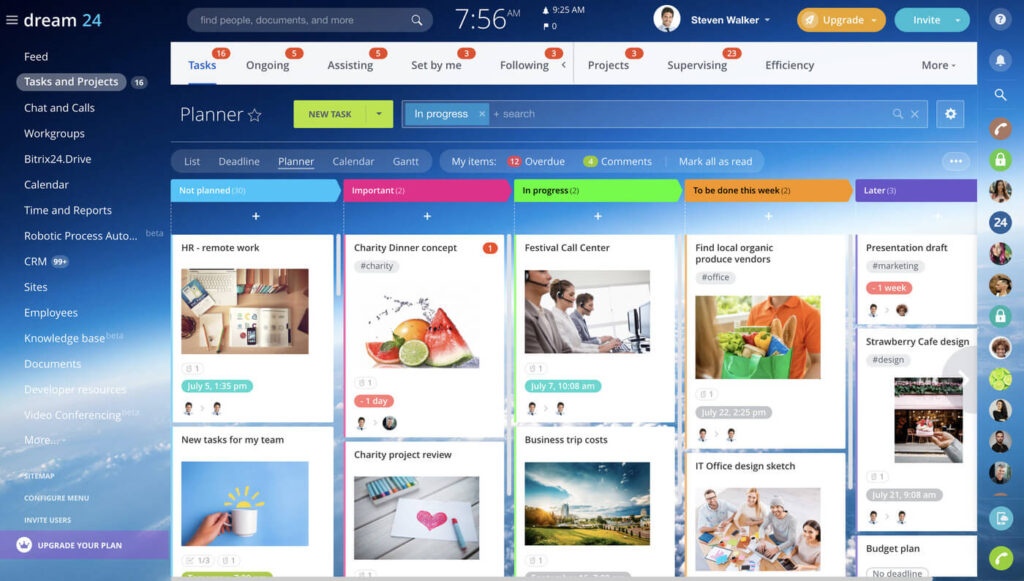
Bitrix24
Bitrix24 stands out in the landscape of business software, offering an all-in-one solution for project management, CRM insights, and HR practices automation. Central to Bitrix24 are its capabilities in communication, CRM, and collaboration, making it a comprehensive management tool. It’s particularly notable for its versatility, aligning with the needs of various business functions, from task management to small business accounting software.
Advantages of Bitrix24:
- Offering total control over data and source code, along with the ability to develop native tools, Bitrix24’s self-hosting option is a standout feature for businesses seeking more autonomy.
- Users can create, assign, and monitor tasks and projects effortlessly from a single dashboard, streamlining task management processes.
- Track employee timesheets, manage leave requests, and generate reports with ease, making HR tasks more efficient.
- Make calls, host video conferences, or chat with customers directly within Bitrix24, enhancing CRM capabilities.
Limitations of Bitrix24:
- Recurring Tasks and Project Templates – In the free version, the ability to create recurring tasks and access project templates is unavailable.
- New users may find the interface complex, potentially requiring a learning curve.
- While the free version offers a range of tools, it comes with limitations in storage, speed, customization, and responsiveness, especially noticeable in the website builder feature.
Pricing:
- Free forever plan: Includes unlimited users, basic collaboration tools, task and project management, CRM functionalities, and 5GB storage – positioning it as one of the best free CRM software options.
- Basic Plan: Priced at $49/month for 5 users, this plan expands storage to 24GB and adds more features including project management, contact center, and an online store.
- Standard Plan: At $99/month, it extends the free plan offerings to 50 users, along with enhanced support and 100GB storage.
- Professional Plan: For $199/month, it provides unlimited users, advanced sales intelligence, and extensive business process automation and HR automation features, along with a significant storage boost to 1024GB.
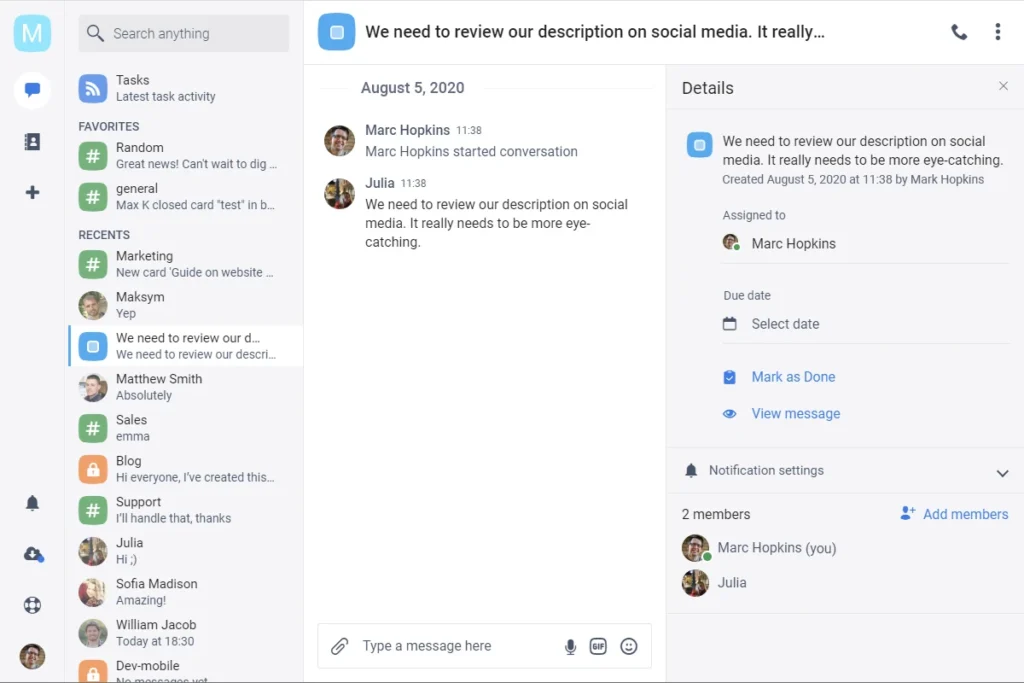
Chanty
Chanty stands out as an exemplary team collaboration tool, specifically designed to enhance team productivity through streamlined communication. Renowned for its simplicity and effectiveness, Chanty facilitates not just team conversations, but also extends its capabilities to essential areas like document management, making it an ideal choice for teams focused on key performance indicators and business performance.
Advantages of Chanty:
- Centralized Teambook Dashboard – this feature allows for the effective organization of tasks, conversations, and files, simplifying document and file sharing within teams.
- Prioritize and highlight crucial deadlines, ideas, and tasks, ensuring that vital information is always readily accessible.
- The tool offers the flexibility to set roles, permissions, and privileges, which is vital for contact management and maintaining team hierarchy.
- Chanty’s user interface is designed for simplicity, making it super easy to tailor to the evolving needs of a business.
- With just a few clicks, team members can turn messages into actionable tasks, a key feature for those looking to manage projects efficiently.
Limitations of Chanty:
- Screen Sharing in Free Plan – one notable drawback is the absence of screen sharing in the free plan, which might be a constraint for teams that rely heavily on visual collaboration.
- The tool offers limited task view choices, restricted to Kanban and calendar options, which might not cater to more complex project management needs.
- The free version does not allow setting roles and permission controls, which can be a limitation for larger teams or those requiring detailed hierarchy management.
Pricing:
- Free Plan: Ideal for small teams, this plan is free forever and includes unlimited conversations, basic task management features, supports up to 10 members, allows 1 guest user, and offers up to 10 integrations.
- Business Plan: Priced at $3/user/month, this plan expands the offerings with unlimited group video calls, allowance for 3 guests per member, a dedicated support line, and unlimited integrations.
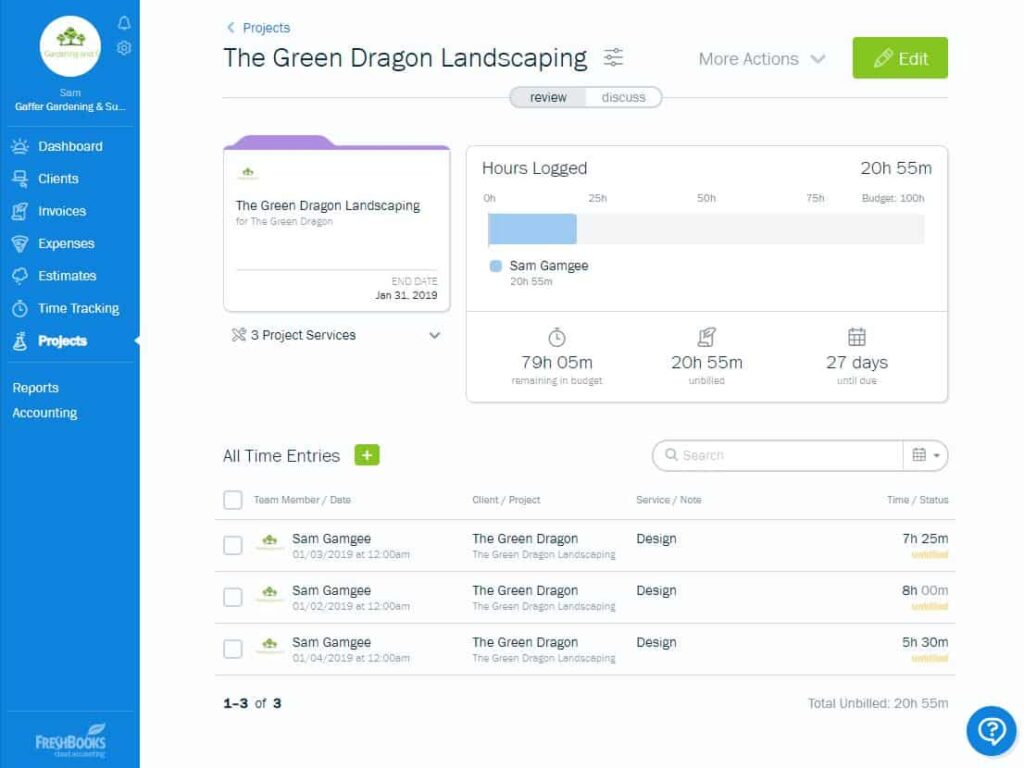
Freshbooks
Tax season often brings a sense of dread for many self-employed individuals and solopreneurs, with the complexities of financial management and accounting looming large. In such scenarios, cloud-based accounting solutions like FreshBooks become a beacon of relief. Regarded as one of the best free software for basic accounting needs, FreshBooks is particularly favored by small businesses and freelancers for its efficiency in tracking billable time and managing financial tasks.
Advantages of FreshBooks:
- Diverse E-commerce Integrations- ideal for businesses using platforms like Squarespace, eBay, Shopify, etc., offering seamless integration for e-commerce accounting.
- Online Payment Acceptance – a crucial feature for freelancers working with global clients, simplifying the payment process.
- Create invoices and send automatic reminders for late payments with just a few clicks, ensuring efficient contact management.
- Manage invoicing and track expenses from anywhere, a handy tool for busy freelancers and business owners.
- Provides a more comprehensive view of business finances and performance, essential for financial planning and analysis.
Limitations of FreshBooks:
- While FreshBooks offers some reporting functions, its capabilities in forecasting and expense estimates are not as advanced as some other solutions.
- Not Ideal for Large Inventory Management – businesses with significant inventory management needs may find FreshBooks lacking in this area.
- Restricted Collaboration Features -the software offers limited functionalities for chat and collaboration on projects.
- The number of billable clients is limited in certain pricing plans, which might be a constraint for businesses as they expand.
Pricing:
- Lite: At $15/month, this plan includes 5 billable clients, unlimited expense tracking, and sales report tracking.
- Plus: Priced at $25/month, offering services to 50 billable clients, this plan adds features like automatic receipt data capture, recurrent billing, client retainers, and the ability to invite an accountant.
- Premium: For $50/month, it caters to unlimited clients and includes all features in the Plus plan, along with customized email options and business health reports.
- Select: This custom pricing plan offers capped ACH fees, a dedicated account manager, accounts for 2 team members, and automatic expense tracking.
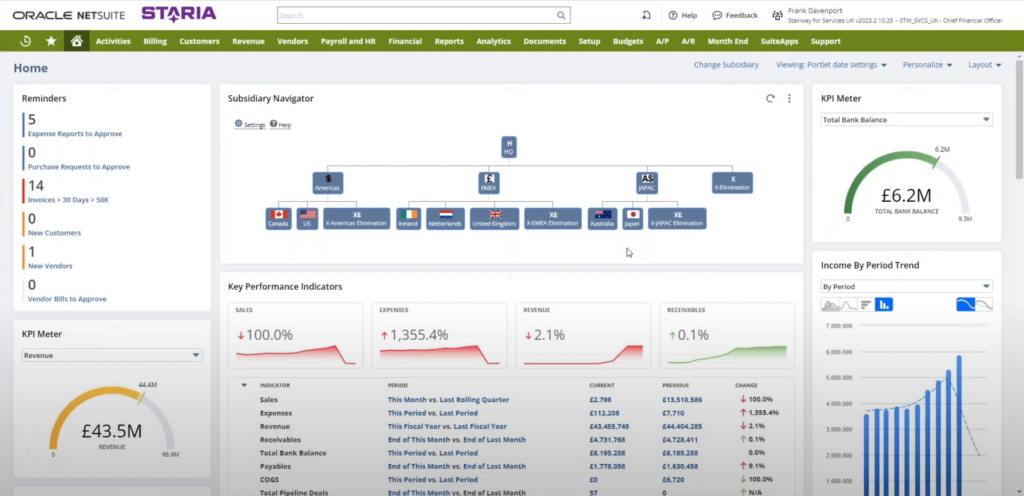
Netsuite
Netsuite distinguishes itself as a versatile ERP software and comprehensive business management platform, adeptly supporting businesses through various stages of growth. This cloud-based enterprise platform is not just a solution for CRM and financial management; it’s also an efficient tool for e-commerce operations. Its ability to centralize business processes on a single server makes it a centralized platform of choice for many enterprises.
Advantages of Netsuite:
- Netsuite excels in streamlining business operations with automated workflows, enhancing both efficiency and consistency.
- The platform provides robust business intelligence capabilities, crucial for making informed decisions as a business expands.
- Its centralized platform offers a unified dashboard to manage and monitor financial and operational performance.
- The flexibility to have various features open simultaneously caters to modern multitasking demands, enhancing the user experience.
Limitations of Netsuite:
- Occasionally, Netsuite may remove certain features, impacting users who relied on them.
- While Netsuite offers basic features, some essential add-ons come at an additional cost.
- The platform’s complex documentation process can be daunting for new users.
- The mobile experience on Netsuite is somewhat limited, which might be challenging for users who need on-the-go access.
Pricing:
- Custom Pricing: Netsuite’s pricing is customized to meet the specific needs of each business, necessitating direct inquiries for detailed information.
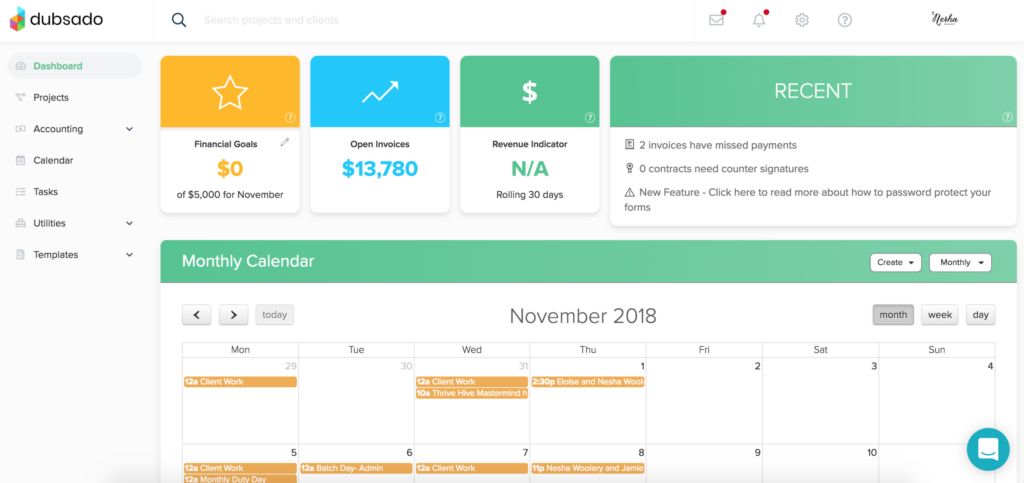
Dubsado
Dubsado presents itself as a versatile and comprehensive platform, expertly designed to streamline operations and manage CRM. This platform is a boon for teams seeking to maintain a seamless workflow, with features that cater to everything from project management to scheduling appointments. With its range of tools, Dubsado stands out for helping businesses make the best-informed purchase decisions.
Advantages of Dubsado:
- Integrated Client Management – utilize integrated emails, client portals, and task boards for efficient client relationship management.
- Features for recurring payments and reminders automate and simplify the financial aspects of your business.
- The scheduler allows clients to easily book calls through your website, enhancing client engagement.
Limitations of Dubsado:
- Restricted Document Sharing – the platform limits document sharing to within project workspaces, posing a challenge for wider collaboration needs.
- New users may require time to familiarize themselves with all the features Dubsado offers.
- The absence of a mobile app can limit accessibility for users who need to manage tasks on the go.
Pricing:
- Starter Plan: Offered at $200/year, it includes unlimited projects and clients, form and email templates, along with invoicing and payment functionalities.
- Premier Plan: At $400/year, this plan adds automated workflows and unlimited lead capture forms to the Starter plan’s features.
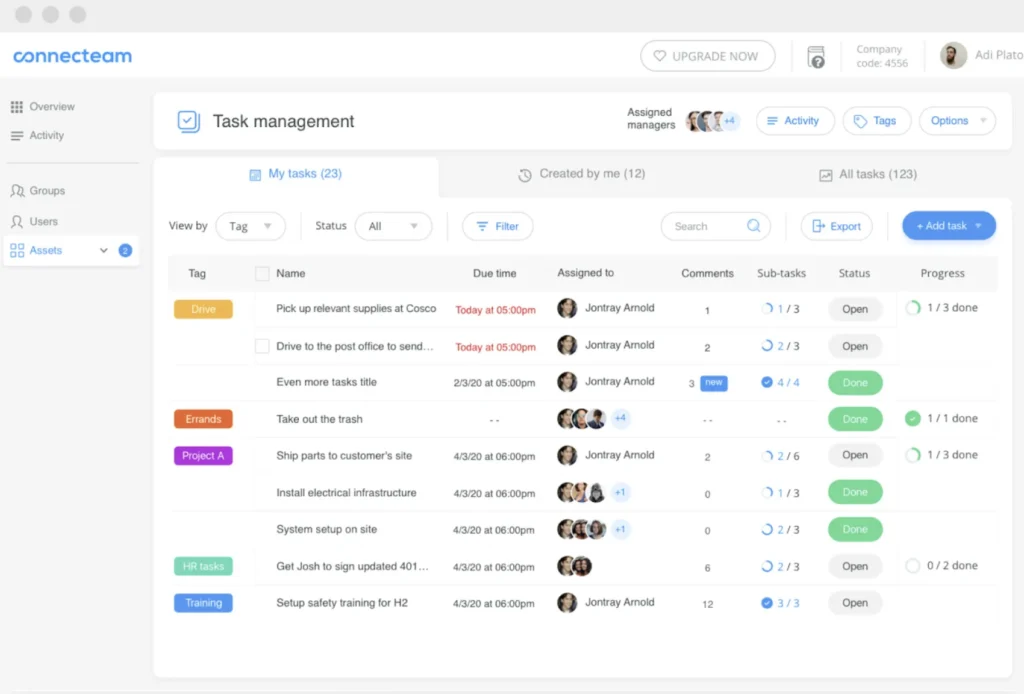
Connecteam
Connecteam emerges as a dynamic, mobile-centric software solution, designed to enhance business management and field service efficiency. It’s especially crafted for businesses seeking a robust system to manage teams, whether they’re in-office, remote, or field-based. This platform is distinguished by its comprehensive suite of features, such as free templates, sophisticated email marketing capabilities, and precise time tracking tools, enabling businesses to create unique solutions tailored to their needs.
Advantages of Connecteam:
- End-of-shift reports encourage management and staff to work together.
- You can efficiently track staff performance with the aid of the time clock tool.
- Messages shared by the entire team allow for easy communication with them.
Limitations of Connecteam:
- Large amount of customizations that can be overwhelming
- Data is segmented between different parts of the app, forcing you to have to go to a new screen to find what you need
- In areas with poor internet connectivity, the software’s performance can slow down
Pricing:
- Small Business Plan: Free, ideal for startups and small teams.
- Basic Plan: $29/month for up to 30 users, suitable for growing businesses.
- Advanced Plan: $49/month for up to 30 users, designed for businesses needing broader features.
- Expert Plan: $99 for up to 30 users, best for large enterprises requiring full-scale functionalities.
Conclusion
Teamplate stands out as an intuitive platform that not only streamlines workflow but also significantly enhances your team’s productivity in managing various business activities. This comprehensive tool encapsulates everything needed for effective business management, from enabling collaboration to automating processes and facilitating smooth communication.
With its focus on providing key features that support business applications, Teamplate ensures that your team can capitalize on sales opportunities more efficiently. Its integration with systems like QuickBooks Online simplifies online payments, making financial management a breeze. Moreover, its adaptability with mobile apps offers the flexibility to manage teams and marketing campaigns on the go.
By adopting Teamplate, you’re not just investing in a tool; you’re making the best informed purchase decision for your business’s future. Experience firsthand how Teamplate transforms the way your team operates, ensuring that your business is well-equipped to handle the dynamic demands of the modern world. Embrace Teamplate to streamline your workflow today and propel your business to new heights of efficiency and collaboration.

